Essaouira
30/09/07 19:16 Filed in: Morocco
After motoring throughout the night we arrived off Essaouira at 08:00. It was flat calm and we followed the leading marks in before turning north into the harbour.
Approaching Essaouira.

We made fast to another Moroccan maritime emergency vessel "Tensift", a sister ship to the one we had been alongside in El Jedida.
The engineer on duty immediately demanded payment for his trouble in taking our lines. Formalities were much shorter. I visited the Surete National where details of crew and vessel were taken and our passports stamped in. Then I visited the Gendarmerie where the same details were written in a ledger.
The atmosphere here appeared more relaxed. Perhaps because there were a lot of visitors. Three coach loads in the port area when we arrived.
Back on board the engineer resumed his demands for payment. Then he told us that the emergency vessel might leave at any time and we could not leave "Kiriwina" unattended. We the moved alongside the day trip passenger boat "Ciel et Mer".
Our berth in Essaouira.
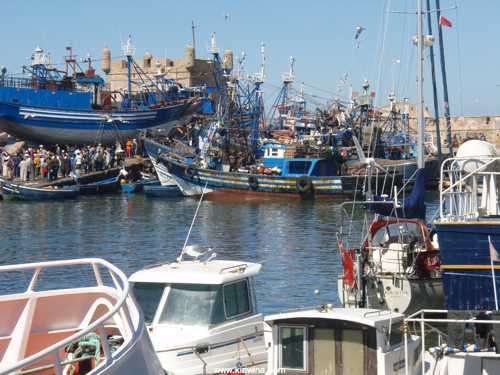
There was quite a bit of surge and Kiriwina's fenders were taking a battering and gradually being coated with blue paint from "Ciel et Mer".
Her skipper said that he might leave at any time on a passenger trip and both he and his son were relentless in their demands for money, whisky, beer and shampoo. The son demanded 200 Drm to guard our boat. When this was refused he said he would ot be responsible if anything "happened" to Kiriwina. Meantime the engineer from "Tensift" had not given up. He followed us down the quay and from "Ciel et Mer" resumed his demands from payment. He finally gave up when told there would be no payment.
Throughout the afternoon the skipper and his son from "Ciel et Mer" relentlessly pressed for payment. Give me a break!
Later in the afternoon a Spanish Nauticat 33, "Gran Siesta" arrived en route from La Coruña to Gran Canaria. She moored outside us and we had a break from the hustlers as they turned their attention to the Spanish boat.
Finally the skipper and his son went home. There had been no day cruise. Later we were able to go ashore and vist this attractive town. It was much cleaner and very pleasant to stroll around. Thankfully there were no hustlers ashore.
Anti stress medecine and other remedies.
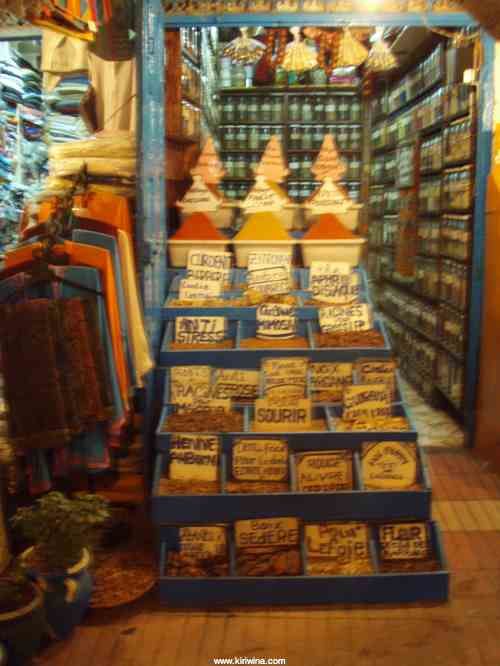
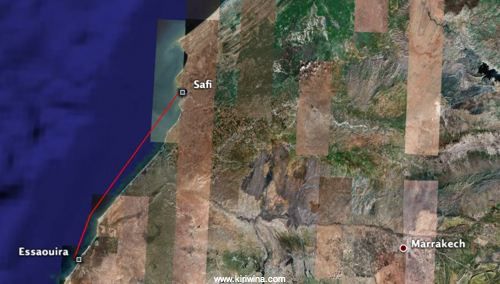
Approaching Essaouira.

We made fast to another Moroccan maritime emergency vessel "Tensift", a sister ship to the one we had been alongside in El Jedida.
The engineer on duty immediately demanded payment for his trouble in taking our lines. Formalities were much shorter. I visited the Surete National where details of crew and vessel were taken and our passports stamped in. Then I visited the Gendarmerie where the same details were written in a ledger.
The atmosphere here appeared more relaxed. Perhaps because there were a lot of visitors. Three coach loads in the port area when we arrived.
Back on board the engineer resumed his demands for payment. Then he told us that the emergency vessel might leave at any time and we could not leave "Kiriwina" unattended. We the moved alongside the day trip passenger boat "Ciel et Mer".
Our berth in Essaouira.

There was quite a bit of surge and Kiriwina's fenders were taking a battering and gradually being coated with blue paint from "Ciel et Mer".
Her skipper said that he might leave at any time on a passenger trip and both he and his son were relentless in their demands for money, whisky, beer and shampoo. The son demanded 200 Drm to guard our boat. When this was refused he said he would ot be responsible if anything "happened" to Kiriwina. Meantime the engineer from "Tensift" had not given up. He followed us down the quay and from "Ciel et Mer" resumed his demands from payment. He finally gave up when told there would be no payment.
Throughout the afternoon the skipper and his son from "Ciel et Mer" relentlessly pressed for payment. Give me a break!
Later in the afternoon a Spanish Nauticat 33, "Gran Siesta" arrived en route from La Coruña to Gran Canaria. She moored outside us and we had a break from the hustlers as they turned their attention to the Spanish boat.
Finally the skipper and his son went home. There had been no day cruise. Later we were able to go ashore and vist this attractive town. It was much cleaner and very pleasant to stroll around. Thankfully there were no hustlers ashore.
Anti stress medecine and other remedies.


Safi to Essaouira
29/09/07 19:16 Filed in: Morocco
At around 08:00 were were woken and told we had to move to allow a pilot boat to berth inside of us. We motored in a circle till the pilot boat was secure, much to the consternation of the police who thought we were leaving, before mooring alongside her.
A typcal Moroccan fishing boat, Safi.
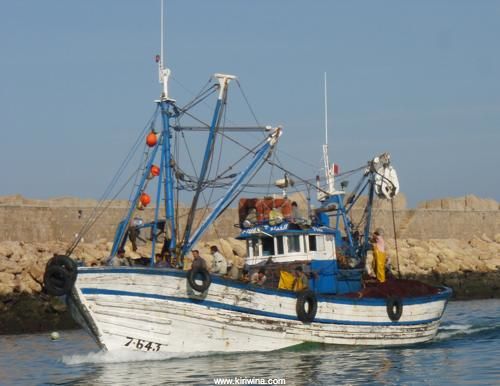
We had been told to visit the harbour office at 10:00 to pay our harbour dues and collect our SSR certificate which had been retained. A polite lady on the top floor started the process. She typed out something which was approved in another office. Then she took the document downstairs where an invoice would be typed. I was asked to return later.
In the interim I went to the Surete National to collect out passports. These were stored in a drawer the keys to which were held by a senior officer who woud not be available for two hours.
I returned to the harbour office. The typed invoice was taken to another office where it was approved and my 30 Drm in fees collected. By now it was 12:00 and I returned to the Surete National. Twenty minutes later the officer arrived and stamped our passports. We could now leave.
We left our berth at 12:45 and cleared Safi harbour at 13:10. We were able to sail for about an hour and a half but by 15:10 the wind had died and we motored at around 3 knots for the rest of the day and throughout the night.
A typcal Moroccan fishing boat, Safi.

We had been told to visit the harbour office at 10:00 to pay our harbour dues and collect our SSR certificate which had been retained. A polite lady on the top floor started the process. She typed out something which was approved in another office. Then she took the document downstairs where an invoice would be typed. I was asked to return later.
In the interim I went to the Surete National to collect out passports. These were stored in a drawer the keys to which were held by a senior officer who woud not be available for two hours.
I returned to the harbour office. The typed invoice was taken to another office where it was approved and my 30 Drm in fees collected. By now it was 12:00 and I returned to the Surete National. Twenty minutes later the officer arrived and stamped our passports. We could now leave.
We left our berth at 12:45 and cleared Safi harbour at 13:10. We were able to sail for about an hour and a half but by 15:10 the wind had died and we motored at around 3 knots for the rest of the day and throughout the night.
Safi
28/09/07 18:09 Filed in: Morocco
Once all the fishing boats had left we had a quiet night.
In the morning they came back leaving us surging up and down in their wake. "Al-Manal" started their auxiliary and an outlet hose began pumping dirty harbour water on our deck.
Our mooring in Safi.
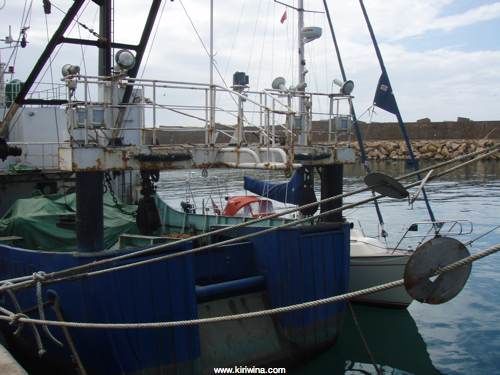
An ageing passenger vessel moored ahead of Kiriwina in Safi.
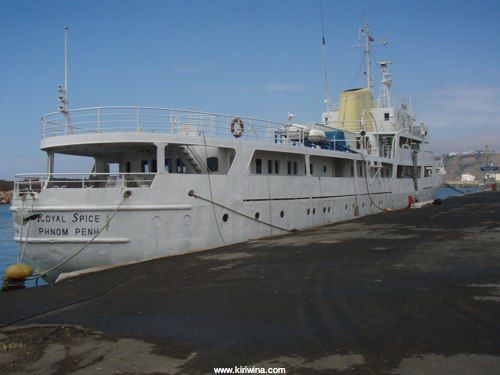
Time to get up, move the hose and attend to our mooring lines. After over 2 weeks in Morocco Kiriwina is very dirty. Some light rain showers gave her a bit of a rinse but she is going to need a good clean when we get to the Canaries.
We went ashore for a stroll visiting first the pottery quarter just outside the city walls and later Safi castle. Another of the many Portuguese castles on this coast.
City walls near the pottery quarter.
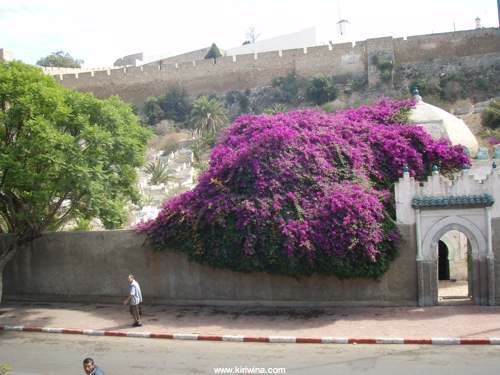
Pottery exterior.
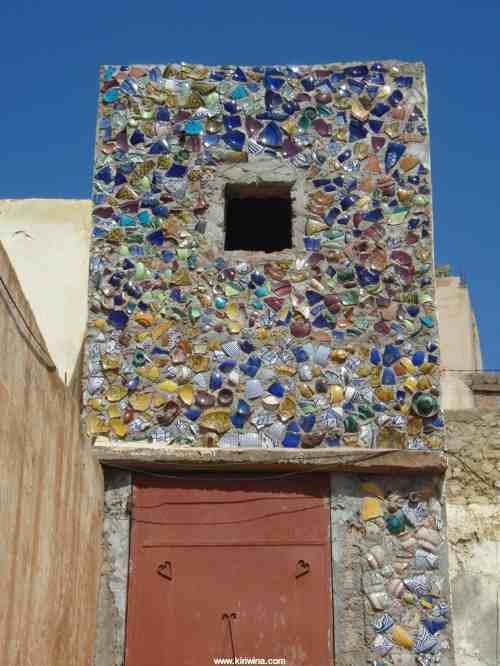
The pottery quarter, Safi.
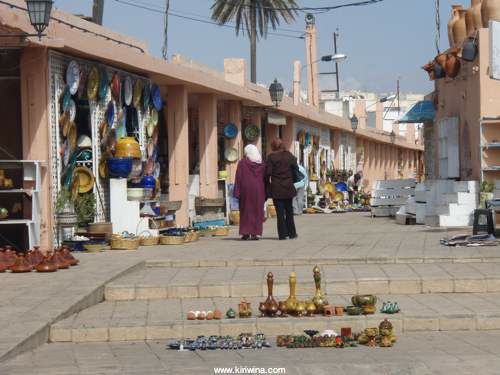
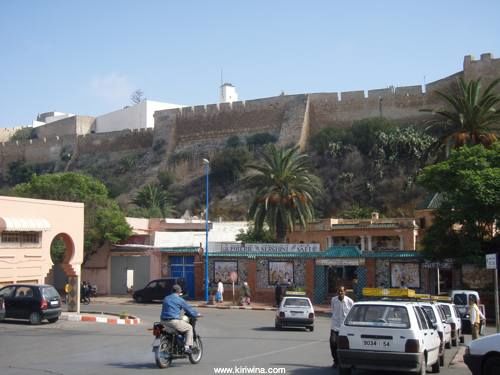
Safi castle overlooking the sea.
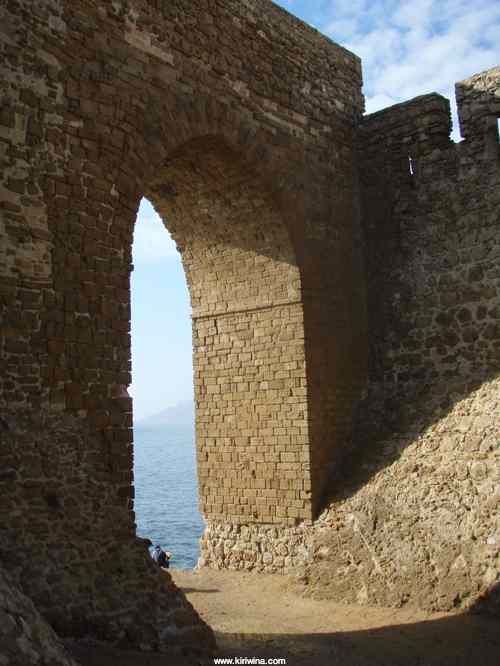
Safi castle with Tomas in the foreground and Safi port in the background.
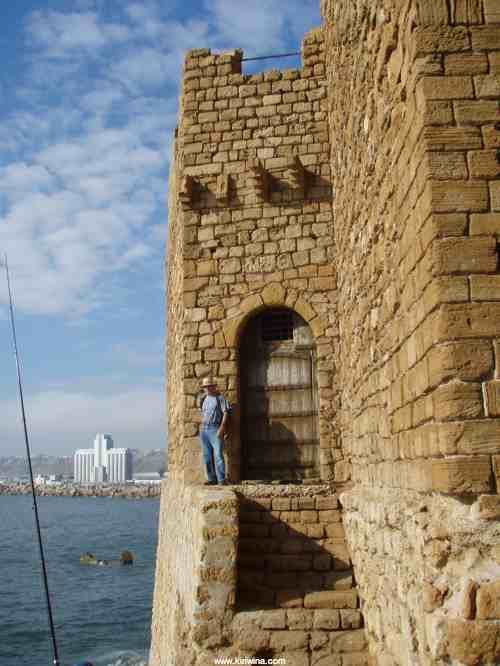
Some very well preserved cannons in Safi castle with...
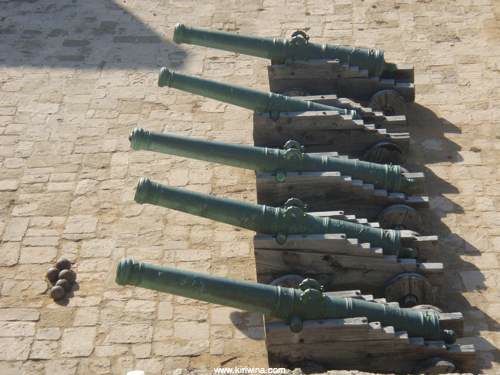
....Arabic markings but made...
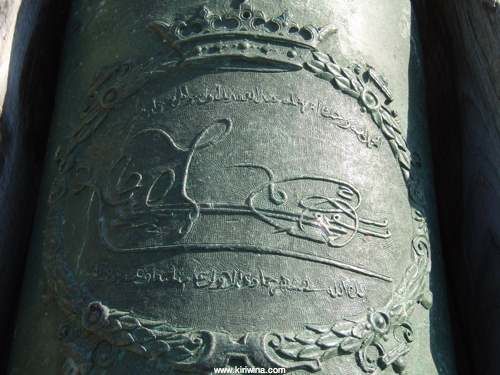
...In The Netherlands with some...
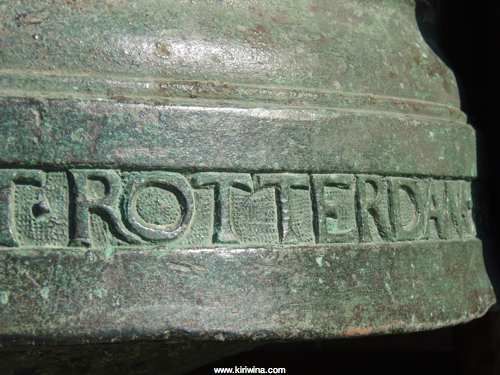
...Interesting detailing.
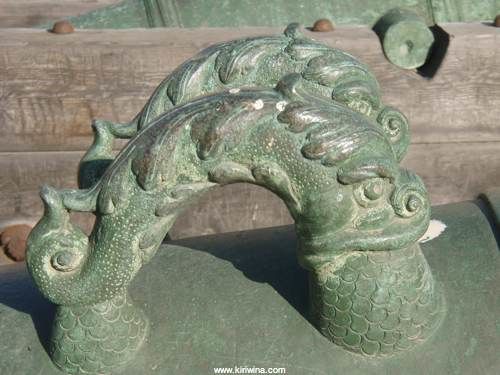
Seaward side - Safi castle.
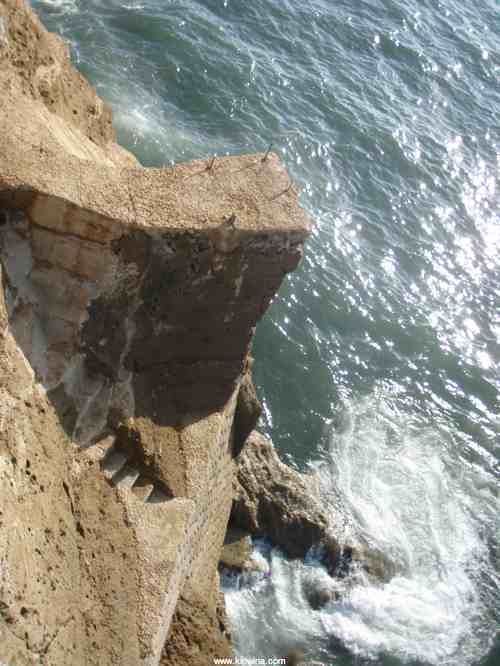
Two cannon flanking an interior ramp to the walls - Safi castle.
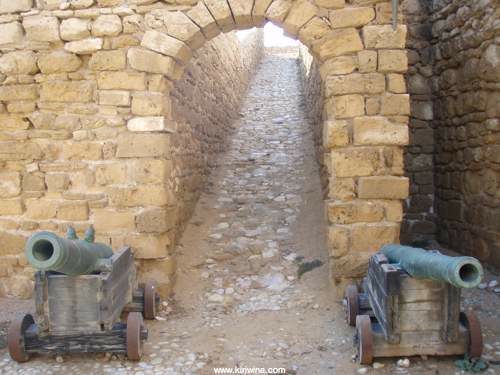
Safi castle.
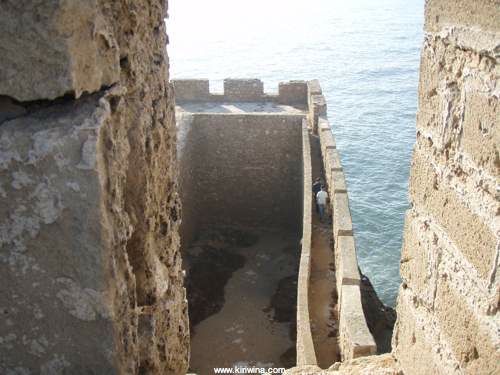
Hustling was irritating in the Medina but minimal elswhere.
In the morning they came back leaving us surging up and down in their wake. "Al-Manal" started their auxiliary and an outlet hose began pumping dirty harbour water on our deck.
Our mooring in Safi.

An ageing passenger vessel moored ahead of Kiriwina in Safi.

Time to get up, move the hose and attend to our mooring lines. After over 2 weeks in Morocco Kiriwina is very dirty. Some light rain showers gave her a bit of a rinse but she is going to need a good clean when we get to the Canaries.
We went ashore for a stroll visiting first the pottery quarter just outside the city walls and later Safi castle. Another of the many Portuguese castles on this coast.
City walls near the pottery quarter.

Pottery exterior.

The pottery quarter, Safi.


Safi castle overlooking the sea.

Safi castle with Tomas in the foreground and Safi port in the background.

Some very well preserved cannons in Safi castle with...

....Arabic markings but made...

...In The Netherlands with some...

...Interesting detailing.

Seaward side - Safi castle.

Two cannon flanking an interior ramp to the walls - Safi castle.

Safi castle.

Hustling was irritating in the Medina but minimal elswhere.
El Jedida to Safi
27/09/07 18:27 Filed in: Morocco
Throughout the early hours we continued to sail slowly down the coast. It was a welcome change to be at sea without the engine running.
That was soon to change. At 08:00 I came on watch and the wind had dropped to virtually nothing and we had fog with about 1/2 mile visibility. The the fog started to clear. As we began to take in the downwind rig we were very suddenly struck by strong winds from the south. In a matter of minutes we went from no wind to S F6 (27 knots max).
This made for a hectic 15 minutes as we put 2 reefs in the main, stowed the pole and furled the yankee. After about half an hour the winds moderated to around 10 knots with occassional gusts to 15-18 knots but always from the south. Our sailing for this trip was over.
We motored the rest of the way into Safi arriving at 15:30 and were directed to moor alongside an old workboat "Al-Manal" where our fender board was needed. Not the best of moorings but OK. Some mountaineering skills were required to get ashore from "Al-Manal".
Officials began to arrive before we had finished mooring. First the police then a different police and immigration. Here our passports were retained and shore passes issued. As in Mohammedia the shore pass specified a curfew from 00:00 until 07:00.
Later the harbour master arrived. He wanted the boat registration document and some goodies.
There was a good deal of surge from passing fishing boats and we had to put protectors on the moorings. A character called Bu-Shaid approached saying he was a ship chandler and could arrange anything we wanted including showers. Tomas took him up on this returning after an hour. The "shower" was a taxi ride away from the port and comprised a public area where Tomas was able to pour saucepans of water, laddled from buckets of hat and cold water, over himself while wearing swimming trunks.
It being Ramadan nothing was open. We ended up in a Golden Tulip hotel where there was at least a working restaurant. I took a risk on a meat dish. Wrong move. I am now vegetarian, at least for the remainder of our stay in Morocco.
Back on board we had a visit from the harbour master. He wanted a form completed with the same information we had given everyone else. Quite why our marital status and occupation are requried to calculate port charges was not clear. He lingered making small talk. We made small talk. Then he got to the point. He had 11 children. Could we give him some goodies. We gave him a bar of chocolate bought in the supermarket in El-Jedida.
By now I had realised it is not a good idea to leave things like torches, mobile phones and sunglasses where they can be seen by officials. They pick things up, have a look and ask the price. They do not say so but the desired outcome is that they be given the object in question. Chocolates and cigarettes OK but that is as far as we will go.
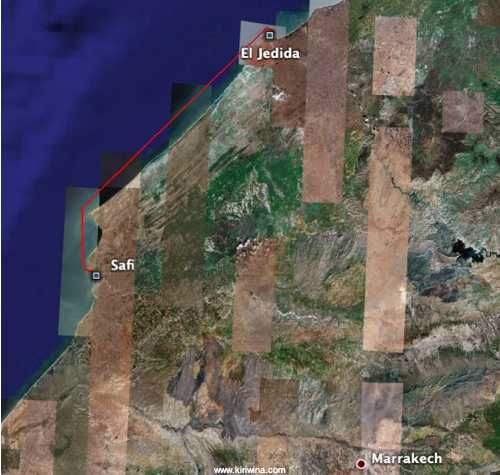
That was soon to change. At 08:00 I came on watch and the wind had dropped to virtually nothing and we had fog with about 1/2 mile visibility. The the fog started to clear. As we began to take in the downwind rig we were very suddenly struck by strong winds from the south. In a matter of minutes we went from no wind to S F6 (27 knots max).
This made for a hectic 15 minutes as we put 2 reefs in the main, stowed the pole and furled the yankee. After about half an hour the winds moderated to around 10 knots with occassional gusts to 15-18 knots but always from the south. Our sailing for this trip was over.
We motored the rest of the way into Safi arriving at 15:30 and were directed to moor alongside an old workboat "Al-Manal" where our fender board was needed. Not the best of moorings but OK. Some mountaineering skills were required to get ashore from "Al-Manal".
Officials began to arrive before we had finished mooring. First the police then a different police and immigration. Here our passports were retained and shore passes issued. As in Mohammedia the shore pass specified a curfew from 00:00 until 07:00.
Later the harbour master arrived. He wanted the boat registration document and some goodies.
There was a good deal of surge from passing fishing boats and we had to put protectors on the moorings. A character called Bu-Shaid approached saying he was a ship chandler and could arrange anything we wanted including showers. Tomas took him up on this returning after an hour. The "shower" was a taxi ride away from the port and comprised a public area where Tomas was able to pour saucepans of water, laddled from buckets of hat and cold water, over himself while wearing swimming trunks.
It being Ramadan nothing was open. We ended up in a Golden Tulip hotel where there was at least a working restaurant. I took a risk on a meat dish. Wrong move. I am now vegetarian, at least for the remainder of our stay in Morocco.
Back on board we had a visit from the harbour master. He wanted a form completed with the same information we had given everyone else. Quite why our marital status and occupation are requried to calculate port charges was not clear. He lingered making small talk. We made small talk. Then he got to the point. He had 11 children. Could we give him some goodies. We gave him a bar of chocolate bought in the supermarket in El-Jedida.
By now I had realised it is not a good idea to leave things like torches, mobile phones and sunglasses where they can be seen by officials. They pick things up, have a look and ask the price. They do not say so but the desired outcome is that they be given the object in question. Chocolates and cigarettes OK but that is as far as we will go.

El Jedida to Safi
26/09/07 19:42 Filed in: Morocco
Before sailing we wanted to return to the Cité Portugaise and visit the water cistern which we hadn't seen the other day. We were pretty early (09:30) but we were preceded by two coachloads of visitors. One French and one Russian.
The cistern, built in 1541, was marvellous and much better preserved than other parts of the city. This was some watertank. More like a church than anything else.
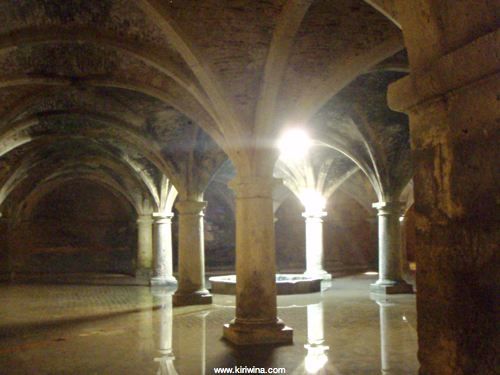
After the cistern we tookt a taxi to a large supermarket on the outskirts of El Jedida. Tomas thought it was Spanish owned and it was quite a contrast to the medinas and kasbahs we have been visiting recently.
Back to the boat and we found that in our absence Rashid had moved Kiriwina along the harbour and moored her outside a small local yacht next to the sailing club. Quite an achievement considering Kiriwina was locked and the awning up. The move had been necessary to allow "Doukalla" to sail.
This was not a good spot and the light local yacht was taking a bit of a pounding. I did the rounds to complete departure formalities.
First to the harbour office to pay dues of 30 Dhm. Then to the police and immigration office to obtain exit stamps in our passports and finally to the customs office where a note was made of our departure.
Ou port costs in El Jedida. Harbour dues 30 Drm, Harbourmaster 2 packs of Cigarettes, Rashid 5 Euros. He wasn't happy with our offer of 30Drm but at this point we only had 200Drm notes.
We sailed at 13:15. It was almost high water yet there was only 5.3 meters in the approach channel. After clearing the harbour we took a long curve around Cape Mazagon to avoid the etensive breaking shoals thereafter proceeding along the coast towards Safi.
The sea was pretty calm with a moderate 2m swell. Today we had wind. Less than 10 knots and from almost dead astern. Be poling out the yankee and rigging a preventer on the main we were able to proceed slowly under sail at around 3 knots.
This wind was as forecast and we continued to sail along the coast for the rest of the afternoon and throughout the evening.
The cistern, built in 1541, was marvellous and much better preserved than other parts of the city. This was some watertank. More like a church than anything else.

After the cistern we tookt a taxi to a large supermarket on the outskirts of El Jedida. Tomas thought it was Spanish owned and it was quite a contrast to the medinas and kasbahs we have been visiting recently.
Back to the boat and we found that in our absence Rashid had moved Kiriwina along the harbour and moored her outside a small local yacht next to the sailing club. Quite an achievement considering Kiriwina was locked and the awning up. The move had been necessary to allow "Doukalla" to sail.
This was not a good spot and the light local yacht was taking a bit of a pounding. I did the rounds to complete departure formalities.
First to the harbour office to pay dues of 30 Dhm. Then to the police and immigration office to obtain exit stamps in our passports and finally to the customs office where a note was made of our departure.
Ou port costs in El Jedida. Harbour dues 30 Drm, Harbourmaster 2 packs of Cigarettes, Rashid 5 Euros. He wasn't happy with our offer of 30Drm but at this point we only had 200Drm notes.
We sailed at 13:15. It was almost high water yet there was only 5.3 meters in the approach channel. After clearing the harbour we took a long curve around Cape Mazagon to avoid the etensive breaking shoals thereafter proceeding along the coast towards Safi.
The sea was pretty calm with a moderate 2m swell. Today we had wind. Less than 10 knots and from almost dead astern. Be poling out the yankee and rigging a preventer on the main we were able to proceed slowly under sail at around 3 knots.
This wind was as forecast and we continued to sail along the coast for the rest of the afternoon and throughout the evening.
El Jedida
25/09/07 10:05 Filed in: Morocco
A relaxed morning was rudely inerrupted when "Doukalla" fired up her auxilliary and main engines for the morning test run.
Kiriwina has quite a high freeboard and "Doukalla" has lowish cooling water outlets so we were OK. A yacht with lower freeboard and similarly moored might get a bit of a shock with a cockpit full of oily water.
Our fenders were sufficient to keep clear of this deep fendering on "Doukalla" though it turned our lines black where they crossed the rubber. There was some surge from passing fishing boats and we had to keep an eye on the moorings.
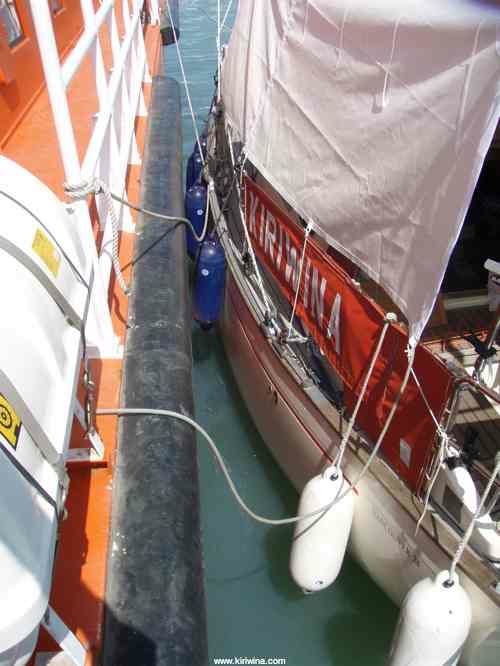
Kiriwina alongside "Doukalla" with fishing boats moored 3 deep astern.
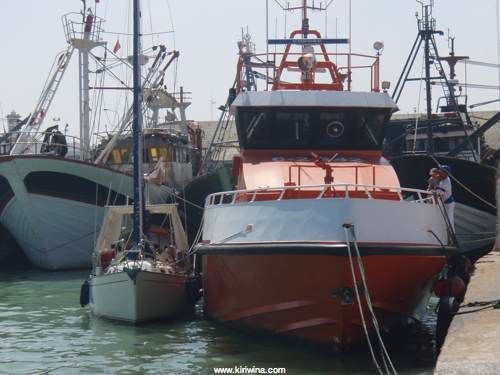
High water at El Jedida. Fisherman are returning with their catch. A large crowd of buyers is waiting on the quay.
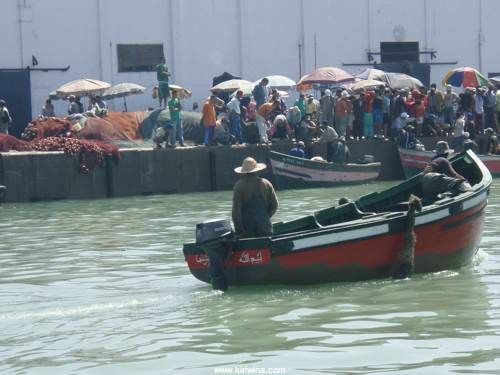
Kiriwina has quite a high freeboard and "Doukalla" has lowish cooling water outlets so we were OK. A yacht with lower freeboard and similarly moored might get a bit of a shock with a cockpit full of oily water.
Our fenders were sufficient to keep clear of this deep fendering on "Doukalla" though it turned our lines black where they crossed the rubber. There was some surge from passing fishing boats and we had to keep an eye on the moorings.

Kiriwina alongside "Doukalla" with fishing boats moored 3 deep astern.

High water at El Jedida. Fisherman are returning with their catch. A large crowd of buyers is waiting on the quay.

El Jedida
24/09/07 18:28 Filed in: Morocco
There was little wind during the night. We motored continuously at low revs. Sometimes we got a little help from the wind giving us an extra knot under Main and Yankee. Mostly the sails just flapped uselessly.
As the sun came up it was virtually flat calm. During the morning we were visted by lots of dragonflies. Some with red bodies some yellow.
Dragonflies on our aerial.
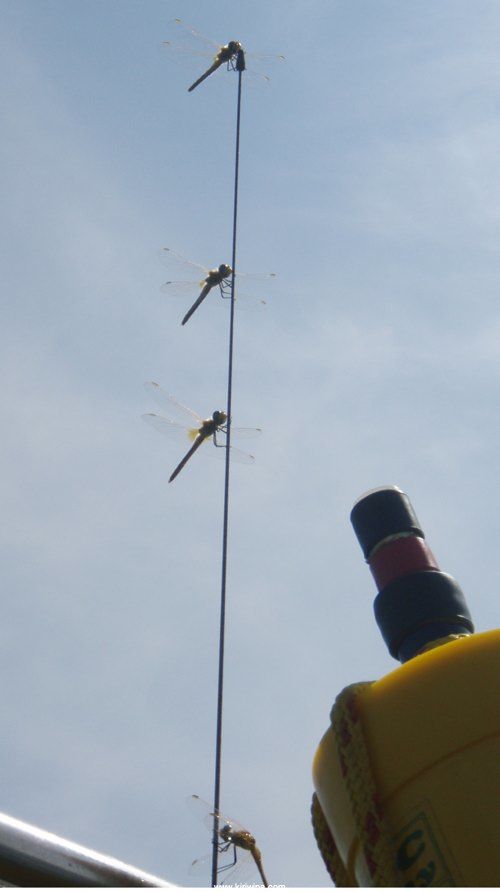
At 11:15, approching El Jedida, we took the sails down and prepared for mooring.
It was almost high tide and the fisherman were returning with their catch.
Following a fisherman into El Jedida harbour with the Cité Portugaise fortress in the background.
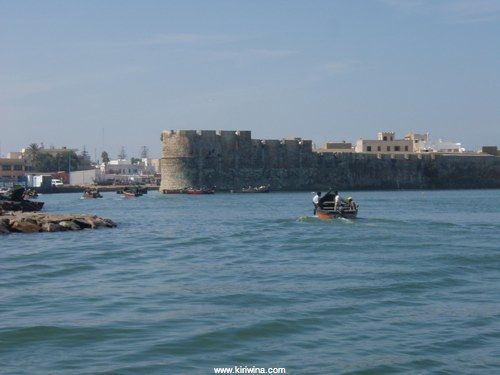
Had we not been able to moor, Tomas thought this would be a good spot to anchor.
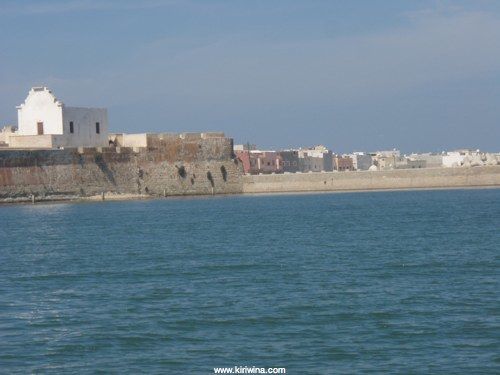
Approaching El Jedida sailing club. There appeared no space for us to moor alongside.
Eventually we moored alongside the bright orange fishery protection vessel.
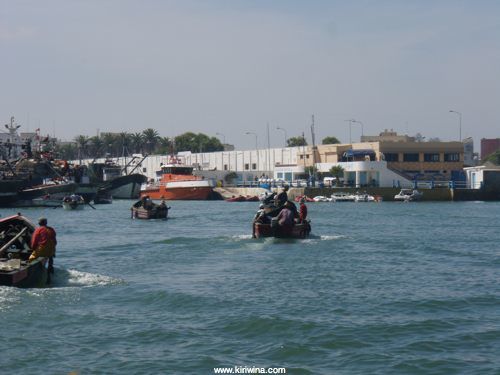
Looking back at the harbour entrance. At almost high tide we had about 5.5 meters depth.
The electronic chart was out by 0.2-0.3 of a mile.
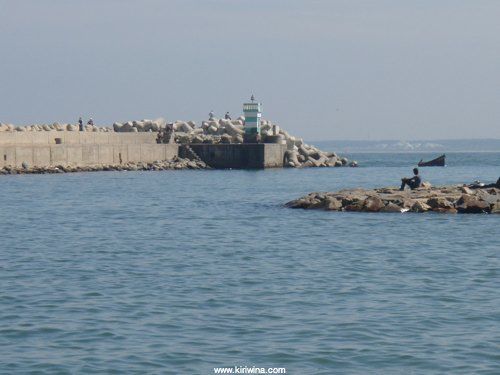
At 12:00 we moored alonside the Moroccan maritime emergency vessel "Doukalla". She is virtually brand new having been built in Spain last year.
She draws 1.5 metres and is capable of speeds up to 30 knots. It was slightly disconcerting to be told by the chief engineer that they sometimes sat on the bottom in this berth.
Fishing boats moored astern of us.
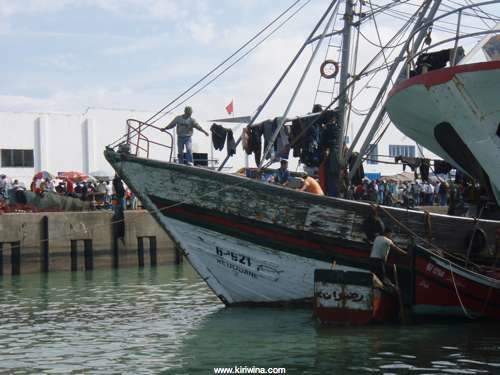
The formalities took about an hour and a half. Firstly the harbourmaster came aboard. I went with him to his office where he filled out a form with our crew and boat details.
Then I went to the harbour administration office where they made some copies of the harbourmaster's form faxed a copy somewhere and retained my SSR Certificate.
Next I visited the customs office where they wrote down the same details on a different form. My last stop was the police and immigration office where four more forms were completed with the same information and our passports stamped. We were done. Pratique was granted.
Proceedings were conducted in good humour at a relaxed pace.
Back on board the very helpful Rachid from the sailing club arranged for shore power with this "Health and Safety" approved connection. He also let us use some basic but very refreshing cold showers in the club.
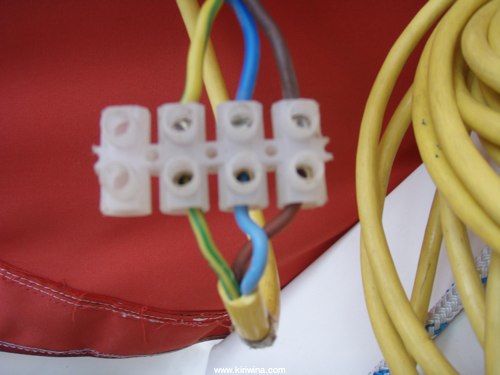
It was time for a run ashore and a visit to the old Cité Portugaise fortress city dating from 1533 but sadly now falling into disrepair in places.
An old French field gun made in Toulouse and possibly dating from WW1.
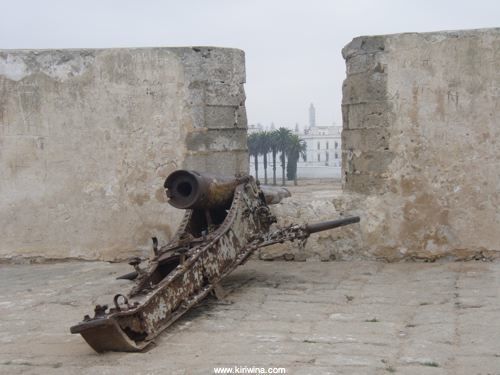
The fortress is magnificent. Occupying a strategic location overlooking the harbour and designed to resist attack from land and sea.
It housed a self contained town.
The harbour entrance at low water seen from the ramparts in Cité Portugaise.
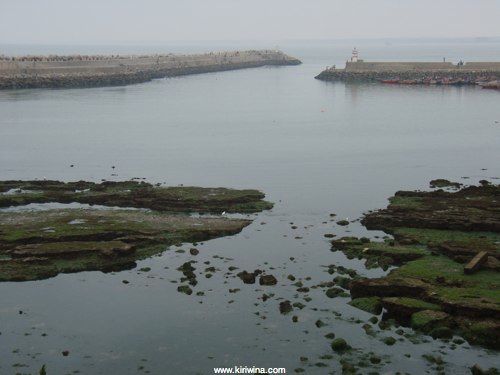
El Jedida fishing harbour and sailing club (foreground) seen from the ramparts in Cité Portugaise.
Kiriwina's mast can just bee seen behind the foreground buildings where beige and white meet.
Beyond the harbour large sandy beaches fade into the distance.
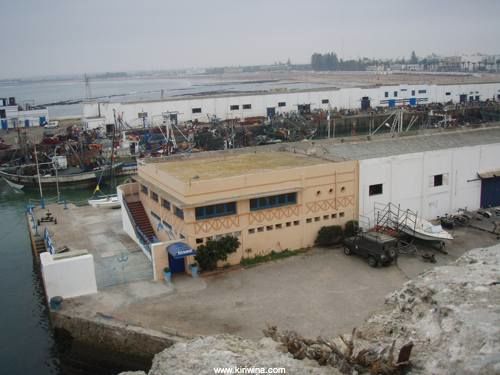
Small fishing boats in the inner harbour next to the fortress.
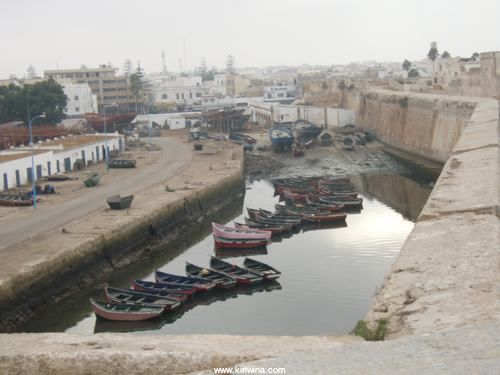
Looking out to sea over the harbour breakwater with suitable placed cannon. The drying area between the fortress and the breakwater is where Tomas had thought we might anchor. Seen here 6 hours later at low water.
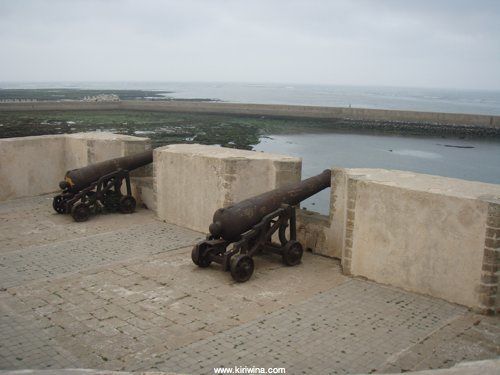
A roof scene from the Cité Portugaise fortress. Typical of the contrasts one sees in Morocco this householder has erected a dish to receive satellite television and repaired his roof with a piece of plastic sheeting held in place with bricks and old pallets.
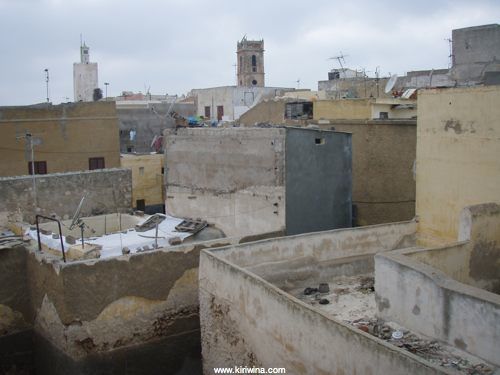
Another (Portuguese?) cannon defending the north wall....
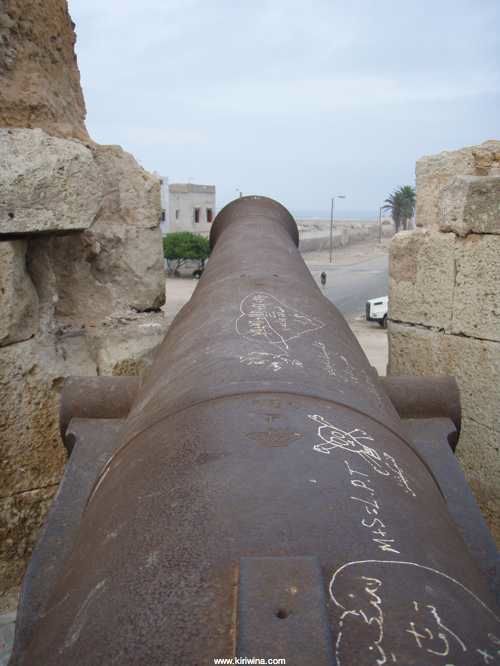
....and bearing these manufacturing marks. I would be interested to know of a source giving the meaning of these marks.
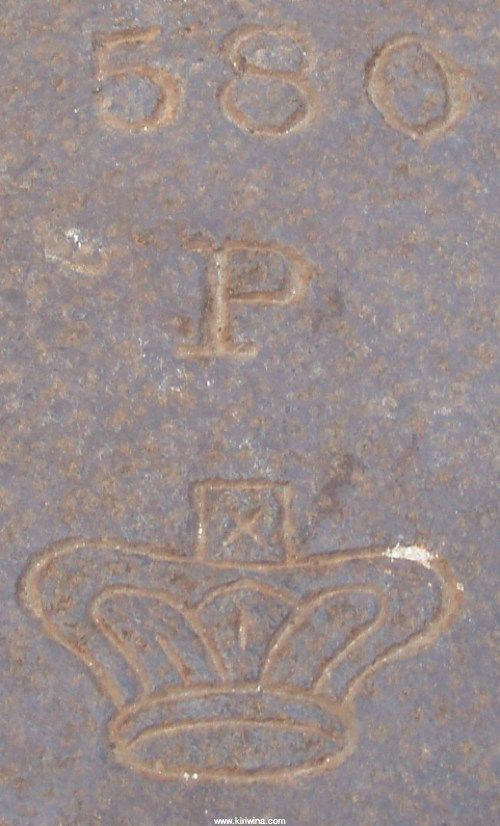
A rare street sign revealing the origins of the Cité Portugaise.
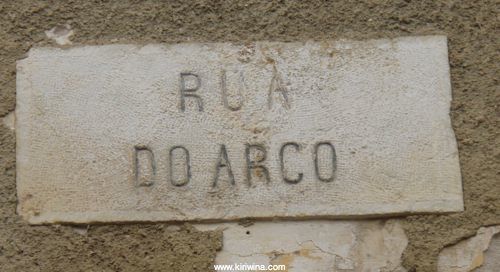
An entrance from modern El Jedida showing just how thick the fortress walls are.
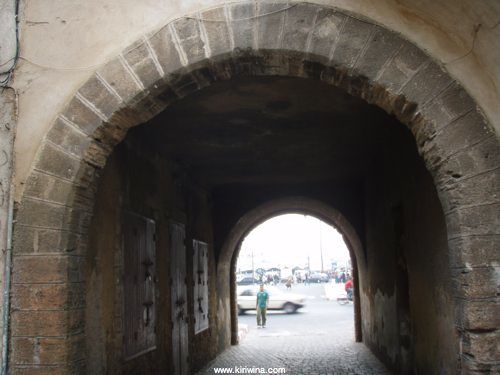
Back in town, we were impressed by the parking discipline shown by this donkey.
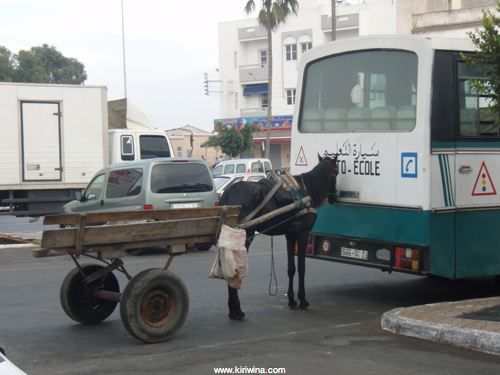
The first theatre we have seen in Morocco.
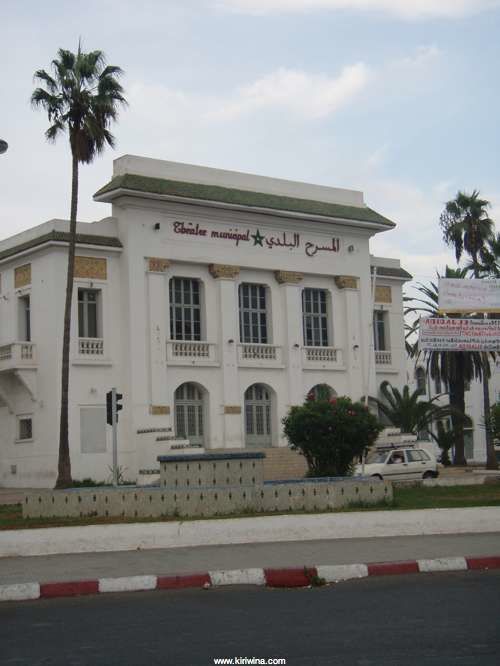
Boulevard de Sete as evening falls. It leads away from a long attractive beach that gently slopes to seeward. As the tide falls a large expanse of sand is exposed. We saw 8 games of beach football in progress.
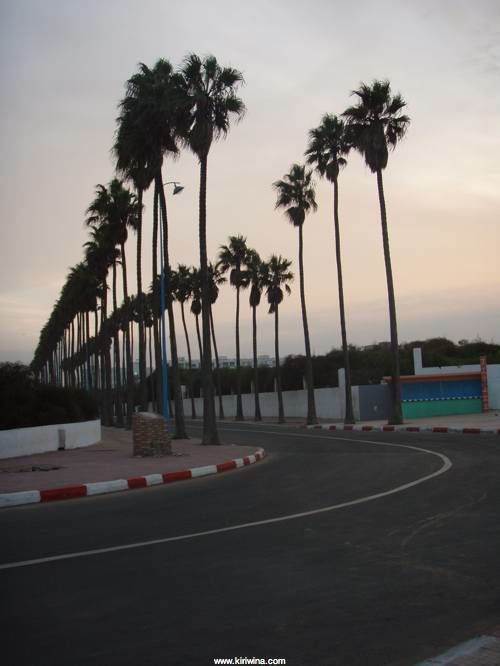
As we entered the port the duty policeman and customs officer were having their evening meal and invited us to join them. It wasn't bad at all and very kind of them. They work long shifts of 24 hrs on 48 hrs off.
Back on board, with low water imminent, our sounder was showing only 1.7m. We ground at 1.3-1.4 metres.
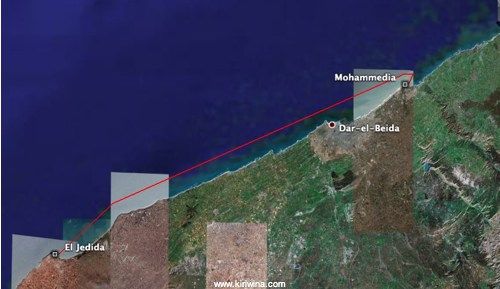
As the sun came up it was virtually flat calm. During the morning we were visted by lots of dragonflies. Some with red bodies some yellow.
Dragonflies on our aerial.

At 11:15, approching El Jedida, we took the sails down and prepared for mooring.
It was almost high tide and the fisherman were returning with their catch.
Following a fisherman into El Jedida harbour with the Cité Portugaise fortress in the background.

Had we not been able to moor, Tomas thought this would be a good spot to anchor.

Approaching El Jedida sailing club. There appeared no space for us to moor alongside.
Eventually we moored alongside the bright orange fishery protection vessel.

Looking back at the harbour entrance. At almost high tide we had about 5.5 meters depth.
The electronic chart was out by 0.2-0.3 of a mile.

At 12:00 we moored alonside the Moroccan maritime emergency vessel "Doukalla". She is virtually brand new having been built in Spain last year.
She draws 1.5 metres and is capable of speeds up to 30 knots. It was slightly disconcerting to be told by the chief engineer that they sometimes sat on the bottom in this berth.
Fishing boats moored astern of us.

The formalities took about an hour and a half. Firstly the harbourmaster came aboard. I went with him to his office where he filled out a form with our crew and boat details.
Then I went to the harbour administration office where they made some copies of the harbourmaster's form faxed a copy somewhere and retained my SSR Certificate.
Next I visited the customs office where they wrote down the same details on a different form. My last stop was the police and immigration office where four more forms were completed with the same information and our passports stamped. We were done. Pratique was granted.
Proceedings were conducted in good humour at a relaxed pace.
Back on board the very helpful Rachid from the sailing club arranged for shore power with this "Health and Safety" approved connection. He also let us use some basic but very refreshing cold showers in the club.

It was time for a run ashore and a visit to the old Cité Portugaise fortress city dating from 1533 but sadly now falling into disrepair in places.
An old French field gun made in Toulouse and possibly dating from WW1.

The fortress is magnificent. Occupying a strategic location overlooking the harbour and designed to resist attack from land and sea.
It housed a self contained town.
The harbour entrance at low water seen from the ramparts in Cité Portugaise.

El Jedida fishing harbour and sailing club (foreground) seen from the ramparts in Cité Portugaise.
Kiriwina's mast can just bee seen behind the foreground buildings where beige and white meet.
Beyond the harbour large sandy beaches fade into the distance.

Small fishing boats in the inner harbour next to the fortress.

Looking out to sea over the harbour breakwater with suitable placed cannon. The drying area between the fortress and the breakwater is where Tomas had thought we might anchor. Seen here 6 hours later at low water.

A roof scene from the Cité Portugaise fortress. Typical of the contrasts one sees in Morocco this householder has erected a dish to receive satellite television and repaired his roof with a piece of plastic sheeting held in place with bricks and old pallets.

Another (Portuguese?) cannon defending the north wall....

....and bearing these manufacturing marks. I would be interested to know of a source giving the meaning of these marks.

A rare street sign revealing the origins of the Cité Portugaise.

An entrance from modern El Jedida showing just how thick the fortress walls are.

Back in town, we were impressed by the parking discipline shown by this donkey.

The first theatre we have seen in Morocco.

Boulevard de Sete as evening falls. It leads away from a long attractive beach that gently slopes to seeward. As the tide falls a large expanse of sand is exposed. We saw 8 games of beach football in progress.

As we entered the port the duty policeman and customs officer were having their evening meal and invited us to join them. It wasn't bad at all and very kind of them. They work long shifts of 24 hrs on 48 hrs off.
Back on board, with low water imminent, our sounder was showing only 1.7m. We ground at 1.3-1.4 metres.

Mohammedia to El Jedida
23/09/07 09:41 Filed in: Morocco
We spent the morning taking down the awning and preparing the boat for sea.
There was a bit of a misunderstanding when I went to pay the mooring fees. First they said they would take credit cards then they said they didn't. I had to return to town to withdraw some cash. Total mooring cost for 11 days Dhm 1100. We lost our free day as they charged for today even though we were leaving.
At 15:15 we left our berth and cleared Mohammedia harbour at 15:30. It had been a good, safe place to stop for a while and tour inland.
Bye bye Mohammedia.
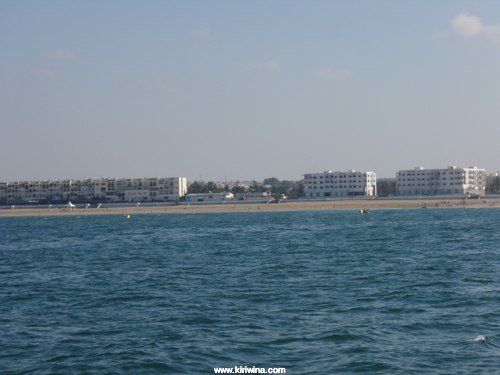
At first we were able to sail under Main and Yankee in light NW winds making a speed of two knots. There was no hurry.
At 19:30 we were off Casablanca and passed slowly by a large container ship at anchor. It was dark. They got a bit nervous and put their spotlight on us.
By 19:45 the wind had died away and we were making less than half a knot through the water. It was time to surrender and put the engine on.
There was a bit of a misunderstanding when I went to pay the mooring fees. First they said they would take credit cards then they said they didn't. I had to return to town to withdraw some cash. Total mooring cost for 11 days Dhm 1100. We lost our free day as they charged for today even though we were leaving.
At 15:15 we left our berth and cleared Mohammedia harbour at 15:30. It had been a good, safe place to stop for a while and tour inland.
Bye bye Mohammedia.

At first we were able to sail under Main and Yankee in light NW winds making a speed of two knots. There was no hurry.
At 19:30 we were off Casablanca and passed slowly by a large container ship at anchor. It was dark. They got a bit nervous and put their spotlight on us.
By 19:45 the wind had died away and we were making less than half a knot through the water. It was time to surrender and put the engine on.
Mohammedia
22/09/07 18:27 Filed in: Morocco
My gearbox dipstick repair failed. However, with the detached thread screwed in and the dipstick pushed home, there seemed a tight enough seal.
The weather was still not in accordance with the forecast of N-NE F3-5. We had SW 2-3 or nothing.
We needed to top up with 60 litres of diesel. This had to be ferried in 20 litre lots from a Total station about a mile away. Than goodness for the Brompton. The cost was 744 Dhm per litre.
A view of the Yacht Club du Maroc - Mohammedia moorings looking towards the harbour entrance.
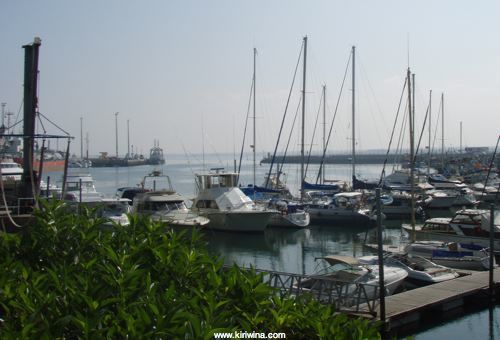
Kiriwina on her "Med" style mooring.
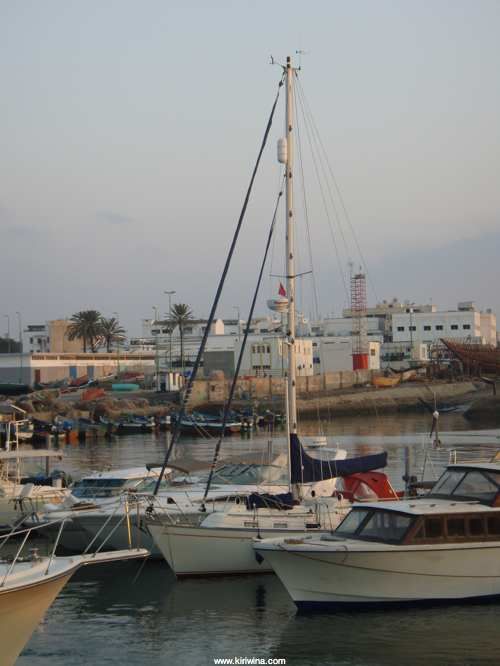
It being Ramadan we returned yet again to one of the few restaurants open, Hotel Jnane Fedala.
Tomas with the doorman.
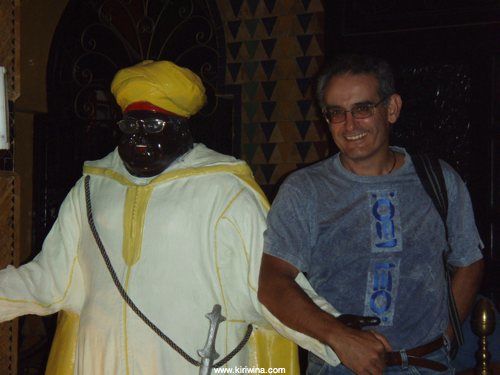
The weather was still not in accordance with the forecast of N-NE F3-5. We had SW 2-3 or nothing.
We needed to top up with 60 litres of diesel. This had to be ferried in 20 litre lots from a Total station about a mile away. Than goodness for the Brompton. The cost was 744 Dhm per litre.
A view of the Yacht Club du Maroc - Mohammedia moorings looking towards the harbour entrance.

Kiriwina on her "Med" style mooring.

It being Ramadan we returned yet again to one of the few restaurants open, Hotel Jnane Fedala.
Tomas with the doorman.

Mohammedia
21/09/07 17:17 Filed in: Morocco
A stay on board day today.
We plan to sail for El Jedida tomorrow or the following day. The forecast today was for N-NE winds F3-4 but we have had nothing but light SW winds which are not a lot of help.
During a routine check of the engine I started to remove the gearbox filler/dipstick plug. I only applied a little pressure and it sheared, the thread breaking away from the cap. A very odd problem but I think it can be solved temporarily with superglue. This might explain the oil found in the engine bay.
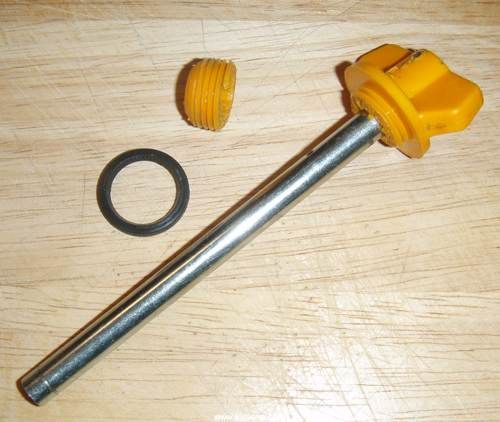
We also deployed our new sun awning for the first time. It works well. The cabin interior is noticeably cooler.
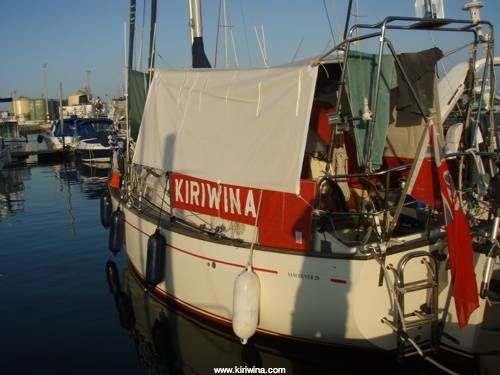
The boom is supported in the normal way with the topping lift passing through the awning.
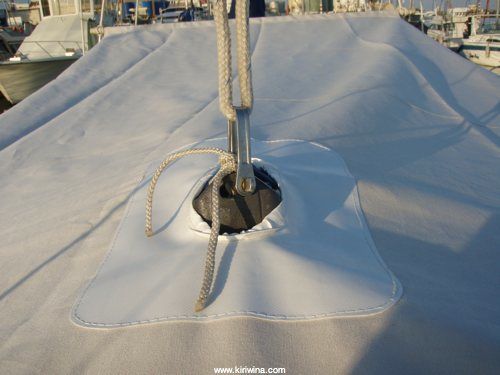
Two poles are slotted into the awning fore and aft. These are then lashed to the shrouds/A-frame. Boy scouts was useful.
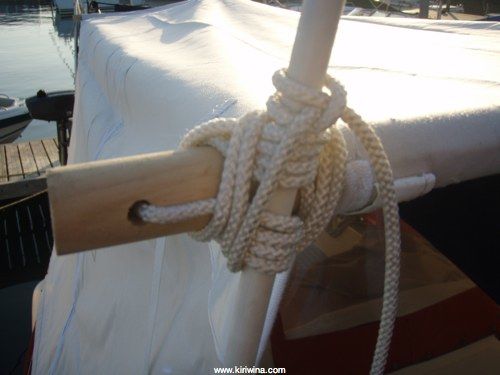
It being Ramadan there was virtually nowhere to eat. The only reliable place we could find was , again, the Hotel Jnane Fedala.
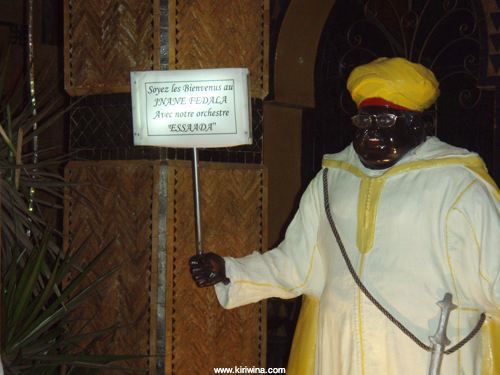
We plan to sail for El Jedida tomorrow or the following day. The forecast today was for N-NE winds F3-4 but we have had nothing but light SW winds which are not a lot of help.
During a routine check of the engine I started to remove the gearbox filler/dipstick plug. I only applied a little pressure and it sheared, the thread breaking away from the cap. A very odd problem but I think it can be solved temporarily with superglue. This might explain the oil found in the engine bay.

We also deployed our new sun awning for the first time. It works well. The cabin interior is noticeably cooler.

The boom is supported in the normal way with the topping lift passing through the awning.

Two poles are slotted into the awning fore and aft. These are then lashed to the shrouds/A-frame. Boy scouts was useful.

It being Ramadan there was virtually nowhere to eat. The only reliable place we could find was , again, the Hotel Jnane Fedala.

Return to Mohammedia via Marrakech
20/09/07 14:15 Filed in: Morocco
When we got up it was raining with quite strong winds.
We had breakfast, paid our bill and left the La Perle du Sud for the last time.
It was a pretty straight forward drive back to Marrakech where we arrived at around 13:00.
First stop was Location Vehicule Widad (Rent a Wreck) to return the car. I had made a list of things on the car they ought to have looked at but they merely said nobody else had noticed anything.
We did find out that the car was only one year old. At 85,000 Km it has had a busy life and, it must be said, done pretty well for a city runabout.
After a drink off the square watching the tourists go by we had a quick walk around before leaving to catch the 15:00 train back to Mohammedia.
Some views of the main square in Marrakech
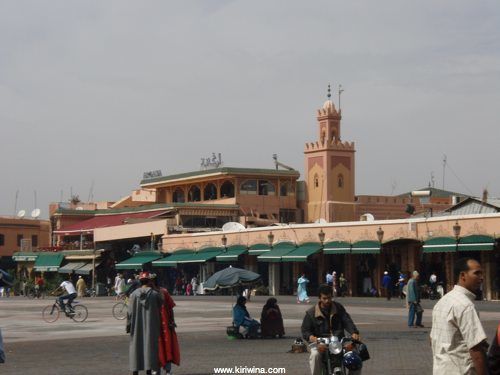
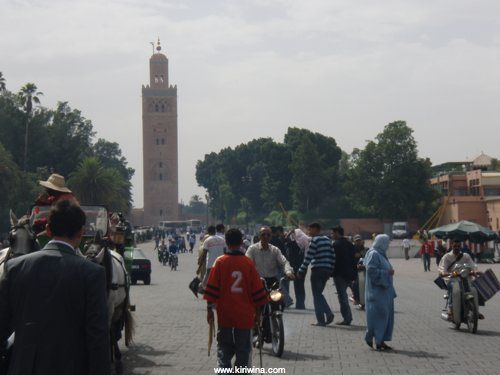
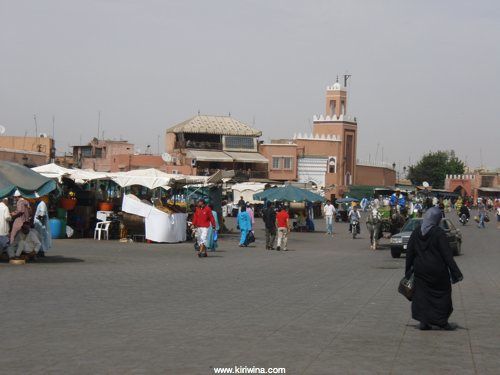
No problems with the train and we were back in Mohammedia at 18:50
We had breakfast, paid our bill and left the La Perle du Sud for the last time.
It was a pretty straight forward drive back to Marrakech where we arrived at around 13:00.
First stop was Location Vehicule Widad (Rent a Wreck) to return the car. I had made a list of things on the car they ought to have looked at but they merely said nobody else had noticed anything.
We did find out that the car was only one year old. At 85,000 Km it has had a busy life and, it must be said, done pretty well for a city runabout.
After a drink off the square watching the tourists go by we had a quick walk around before leaving to catch the 15:00 train back to Mohammedia.
Some views of the main square in Marrakech



No problems with the train and we were back in Mohammedia at 18:50
Gorges du Dadès and George du Todrâ
19/09/07 17:12 Filed in: Morocco
Around 10:00 we set off along the Vallee du Dadès towards Boumaine Dadès. The road wound through flat countryside and frequently crossed dry river beds where it was reinforced to resist immersion in flood waters.
This reinforcing was not always sufficient and the crossings were often in poor condition.
In Boumaine Dadès we turned north towards the Gorges du Dadès.
A scene from the lower end of Gorges du Dadès with unusual rock formations on the right.
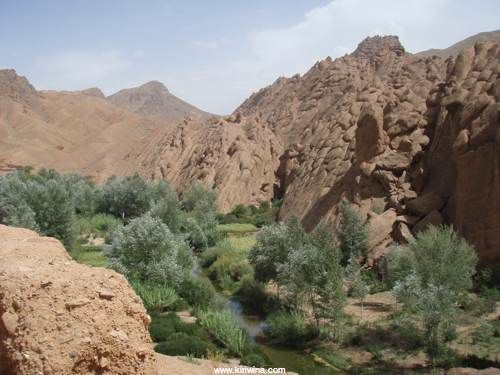
Village women doing their laundry in the very clean river below. One of the few river beds we saw with any water in it.
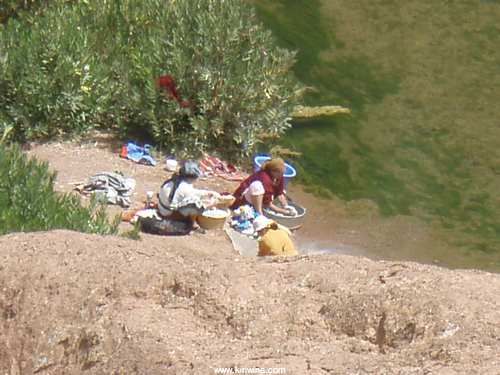
A closer view of the rock formation noted above.
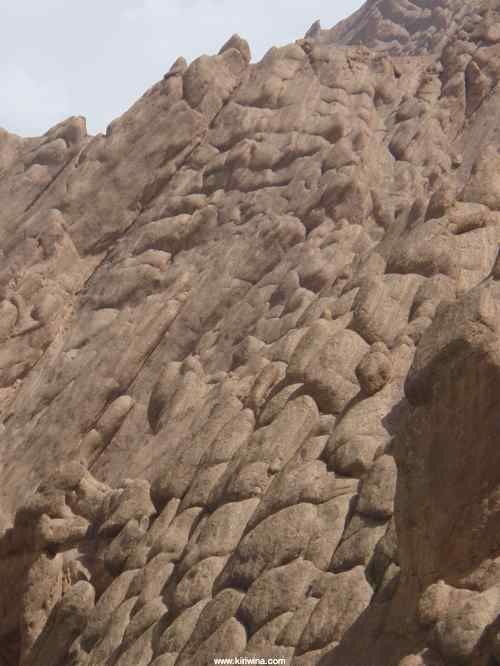
As we followed the Gorge north it deepened and the side became very steep. This switchback road climbed one of the steeper sections.
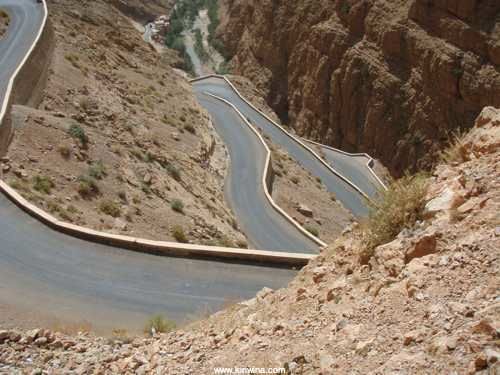
The narrowest point we passed in Gorges du Dadès.
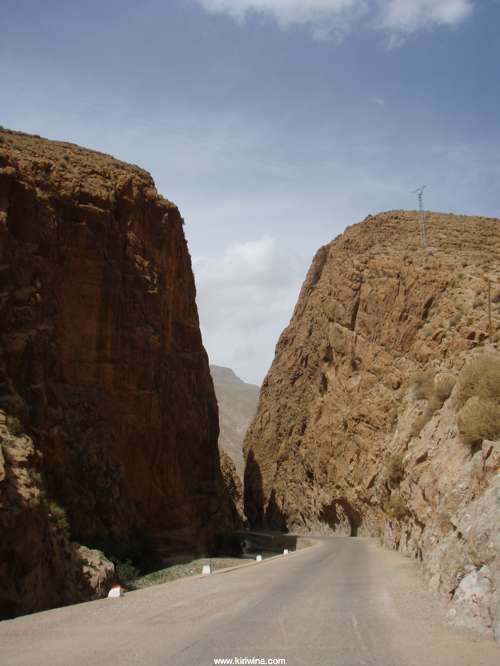
Near this village the hillside was littered with large boulders. This one had been chocked to prevent it rolling any further.
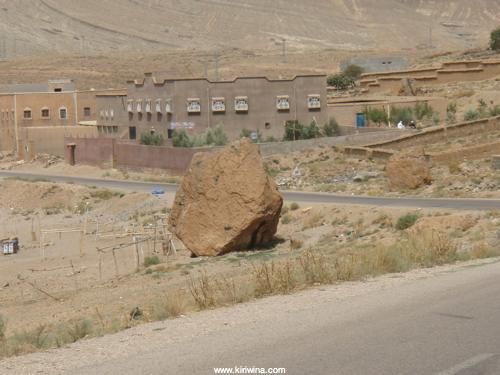
Further along we had climbed out of the gorge. This view of the valley floor was taken from a high point on our road which was narrowing and now devoid of any restraining rails.
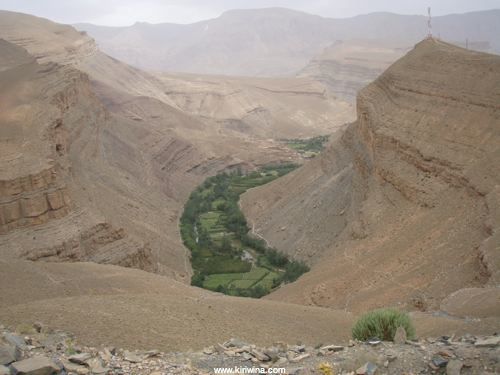
A lunar landscape? Beyond this sign there was an almost vertical drop hundreds of feet to the valley floor. Just after this photo was taken a vendor emerged and tried to sell us, wait for it, rocks! Quite why we would buy one in a landscape littered with them was not clear. perhaps his contained fossils.
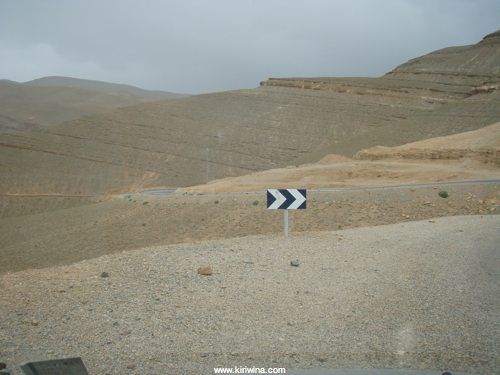
I've never been to the Grand Canyon but this reminded of pictures I'd seen over the years.
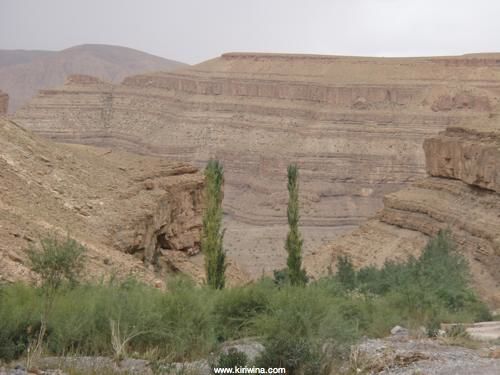
The road conditions had now deteriorated noticeably. Sections that had been washed away were poorly repared and unsurfaced. Our little Atoz was not the most suitable of vehicles for these conditions.
We got as far as the village of Msemrir before the road became rough gravel. A local on the hustle told us the road ahead was slow and only suitable for 4WD vehicles. However if we took him along as our paid guide we would be fine. Interesting logic.
Our plan to do a circular trip and return south along the George du Todrâ was abandoned.
We turned round, drove back to Boumaine Dadès and turned NE towards George du Todrâ.
The lower end of this Gorge was filled with a dense palm plantation...
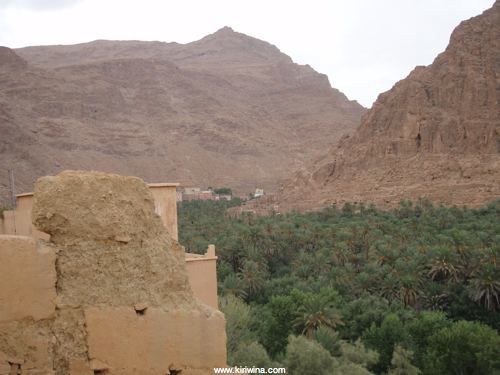
.... extending for about 4km.
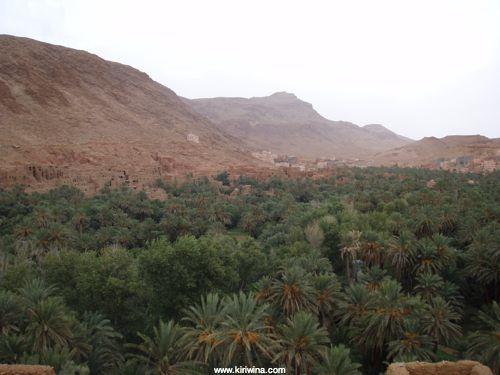
Then the gorge became very steep fairly quickly and the road very poor. A large section of this concrete portion had been washed away and replaced with packed gravel, temporarily?
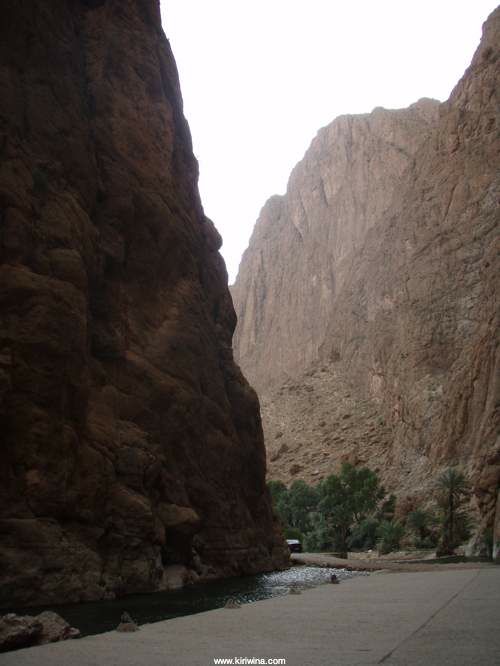
This hotel was sited directly under a almost vertical cliff which to us did not look all that stable. Not my first choice for an overnight stop.
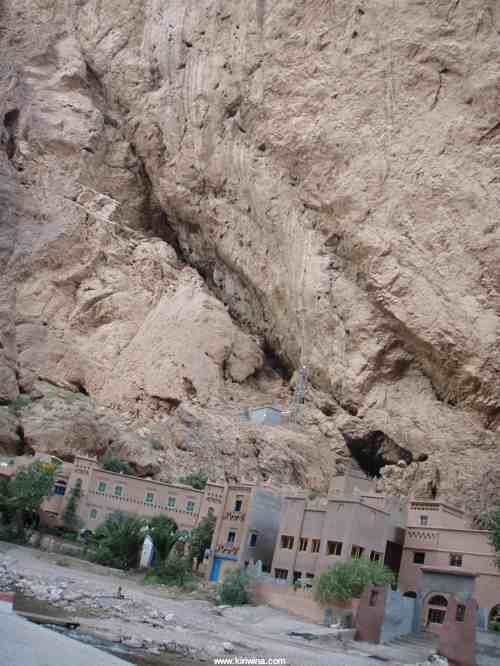
Just beyond this point the road had been washed away again and conditions were such that we could not proceed without a 4WD.
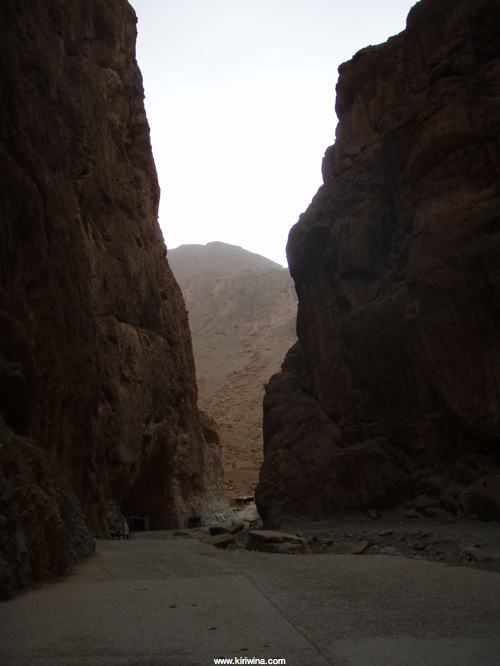
That was that and we turned to return to Ouarzazate. These palms rose up from the gorge floor and were just out of reach from the roadside.
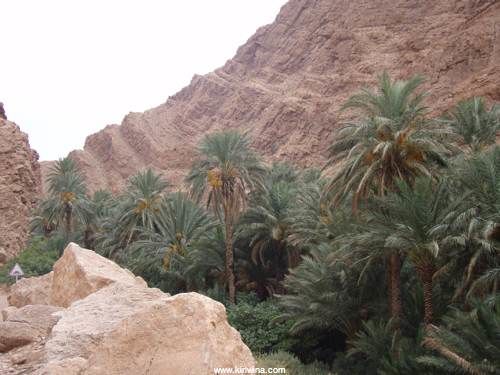
Back in Ouarzazate we tried a third restaurant. After about 10 days in Morocco I have found the restaurant food quality mixed. After two attempts I gave up on meat dishes although Tomas persisted with, he says, some success.
Our Pilot book advises that visitors to Morocco should take a "large" stock of anti diarrohea pills. They got that right!
After dinner we went for a walk around the medina in Ouarzazate.
A spice store in the Medina.
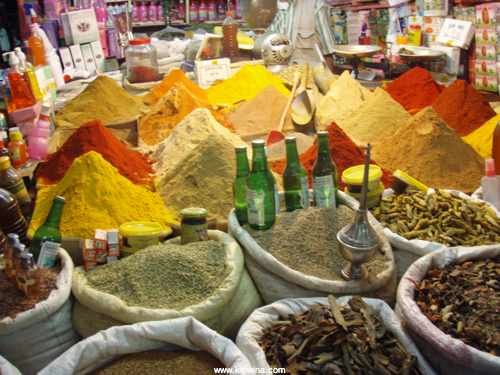
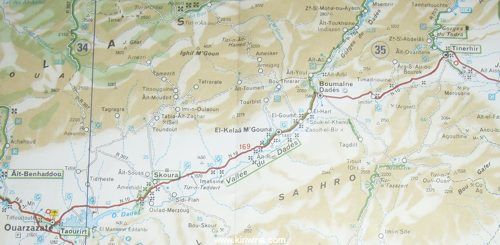
This reinforcing was not always sufficient and the crossings were often in poor condition.
In Boumaine Dadès we turned north towards the Gorges du Dadès.
A scene from the lower end of Gorges du Dadès with unusual rock formations on the right.

Village women doing their laundry in the very clean river below. One of the few river beds we saw with any water in it.

A closer view of the rock formation noted above.

As we followed the Gorge north it deepened and the side became very steep. This switchback road climbed one of the steeper sections.

The narrowest point we passed in Gorges du Dadès.

Near this village the hillside was littered with large boulders. This one had been chocked to prevent it rolling any further.

Further along we had climbed out of the gorge. This view of the valley floor was taken from a high point on our road which was narrowing and now devoid of any restraining rails.

A lunar landscape? Beyond this sign there was an almost vertical drop hundreds of feet to the valley floor. Just after this photo was taken a vendor emerged and tried to sell us, wait for it, rocks! Quite why we would buy one in a landscape littered with them was not clear. perhaps his contained fossils.

I've never been to the Grand Canyon but this reminded of pictures I'd seen over the years.

The road conditions had now deteriorated noticeably. Sections that had been washed away were poorly repared and unsurfaced. Our little Atoz was not the most suitable of vehicles for these conditions.
We got as far as the village of Msemrir before the road became rough gravel. A local on the hustle told us the road ahead was slow and only suitable for 4WD vehicles. However if we took him along as our paid guide we would be fine. Interesting logic.
Our plan to do a circular trip and return south along the George du Todrâ was abandoned.
We turned round, drove back to Boumaine Dadès and turned NE towards George du Todrâ.
The lower end of this Gorge was filled with a dense palm plantation...

.... extending for about 4km.

Then the gorge became very steep fairly quickly and the road very poor. A large section of this concrete portion had been washed away and replaced with packed gravel, temporarily?

This hotel was sited directly under a almost vertical cliff which to us did not look all that stable. Not my first choice for an overnight stop.

Just beyond this point the road had been washed away again and conditions were such that we could not proceed without a 4WD.

That was that and we turned to return to Ouarzazate. These palms rose up from the gorge floor and were just out of reach from the roadside.

Back in Ouarzazate we tried a third restaurant. After about 10 days in Morocco I have found the restaurant food quality mixed. After two attempts I gave up on meat dishes although Tomas persisted with, he says, some success.
Our Pilot book advises that visitors to Morocco should take a "large" stock of anti diarrohea pills. They got that right!
After dinner we went for a walk around the medina in Ouarzazate.
A spice store in the Medina.


Vallée du Drâa and Ait-Benhaddou
18/09/07 17:08 Filed in: Morocco
In the morning, absent any towels, we used sheets.
We had a coffe before heading south along the Vallée du Drâa towards Zagora. On our Michelin map it looked as though the valley was completely filled with palm plantations. It wasn't.
First we had to cross another mountain range, the Jebel Saharo. Not as high as the High Atlas but spectacular nonetheless.
Not a plant in sight. Just bleak mountains and valleys as far as we could see. It was a very long way down on the other side of this barrier.
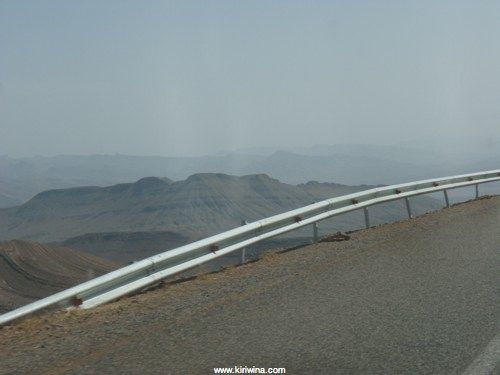
Bleakness on a grand scale.
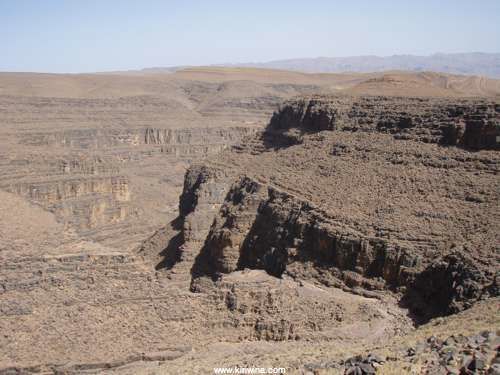
Looking south from the highest pass the Vallée du Drâa with it's river virtually dry and the first of the Palms in the distance.
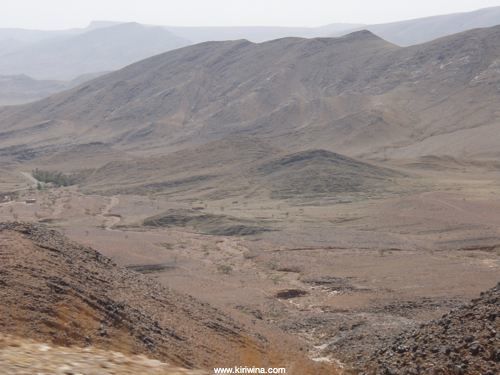
As we passed palm plantations vendors would appear and wave boxes of dates. Their marketing strategy was often suspect as they chose locations without much space to stop and where traffic was travelling quite fast.
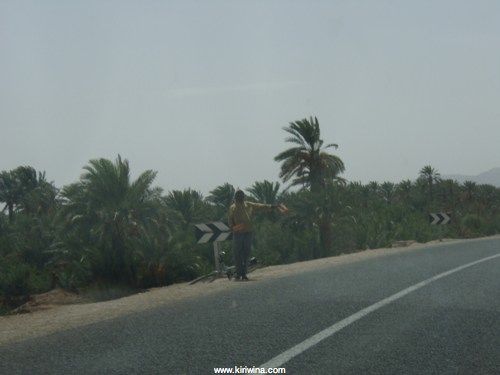
One of the many villages along the valley. All built in a similar style with reddish brown mudbrick.
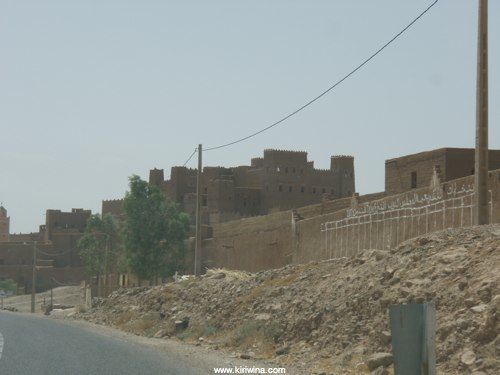
As we approached Zagora the plantations became more extensive. In Zagora itself the hustlers started even before we had stopped the car.
On the way down we had had the car windows open to benefit from a strongish breeze. We hadn't noticed that the breeze was carrying a lot of red dust. We and the car intererior we covered in it.
There seemed little reason to linger. We had a quick drink here before returning north. Now with the windows closed and the air conditioning on.
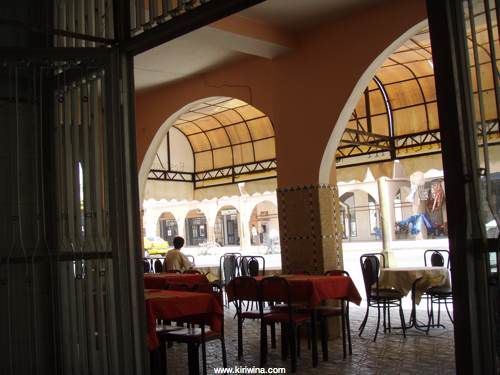
Just outside Zagora we went for a walk through one of the plantations. These were magnificent Palm trees.
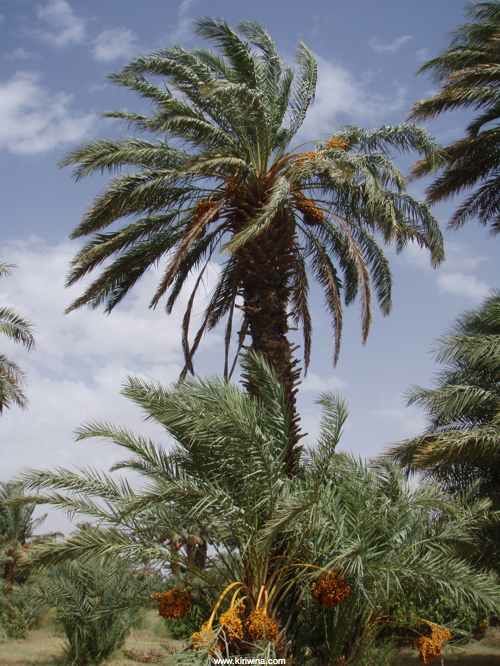
It was almost time for the date harvest. We tried some and they were delicious.
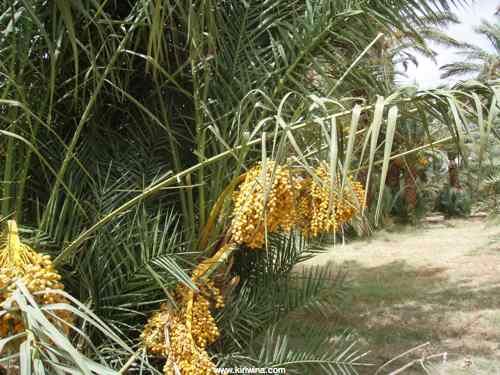
Back into the Jebel Saharo and more of the spectacular rock formations.
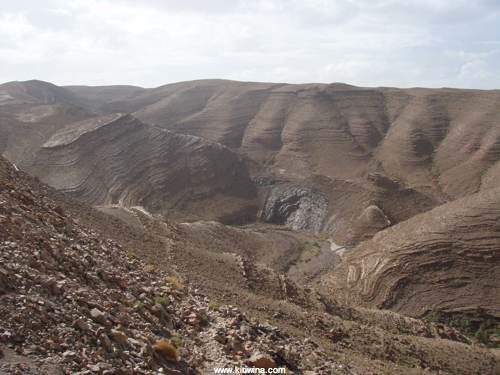
Looking down into a dry river bed. The few palms surviving until it rains again.
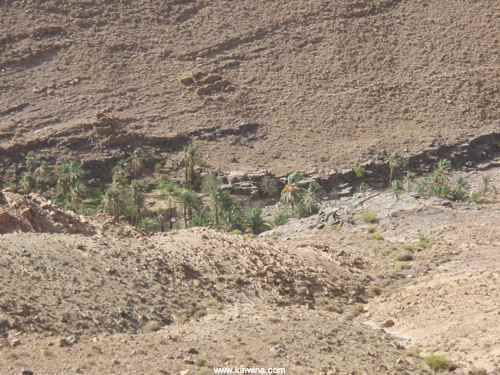
Considering the robust terrain the roads were generally quite good though not suited for high speeds.
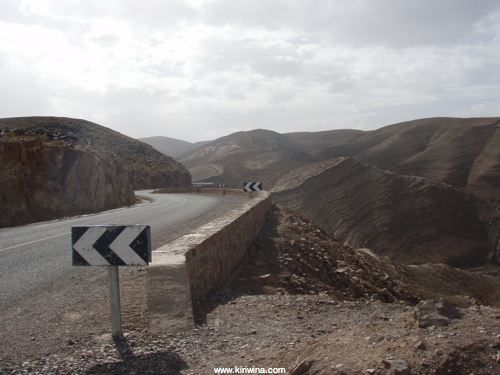
Our little Atoz and the view south.
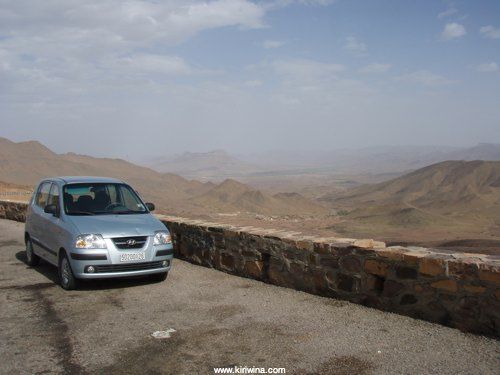
We returned to Oarzazate and carried on to Âit-Benhaddou a few miles to the NW. This turned out to be a hilltop village where we were told a number of films had been shot in the 80's including Indiana Jones and Jewel of the Nile.
Looking towards the village across a wide and dry river bed.
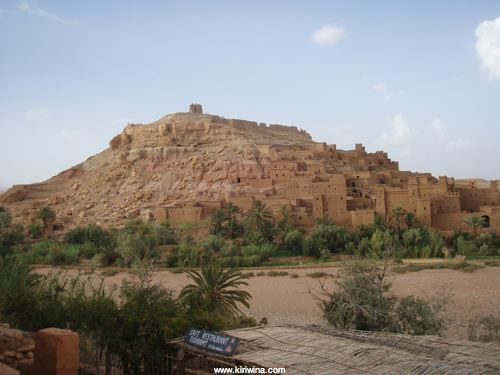
The village looked a bit twee and I wondered whether it had been built especially for filming. Apparently not, as we later saw many similar villages.
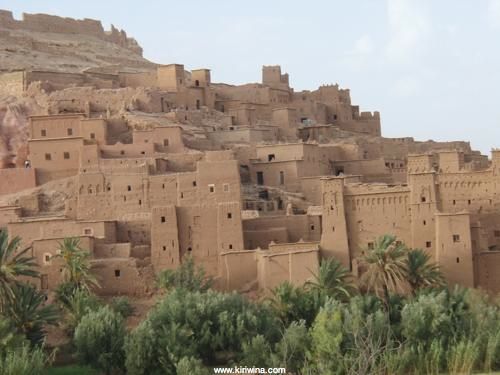
There was a 10Dhm admission into the village to fund "restoration". Once inside it seemed pretty run down, not untypical, although a path to the hilltop was being refurbished.
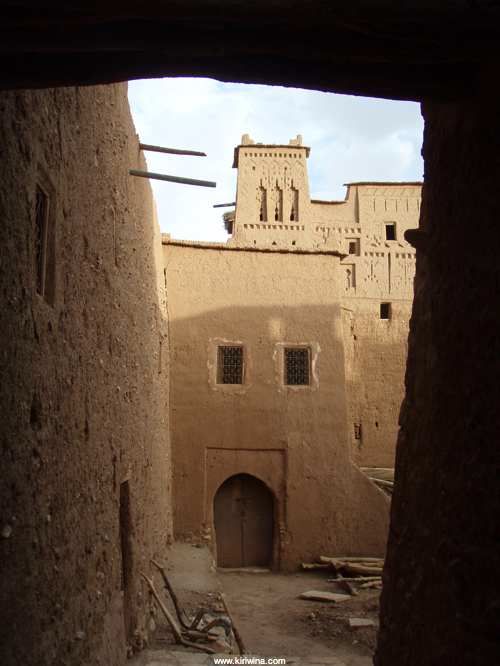
A view from the hilltop with the wide river bed clearly visible. In winter this becomes a fast flowing river.
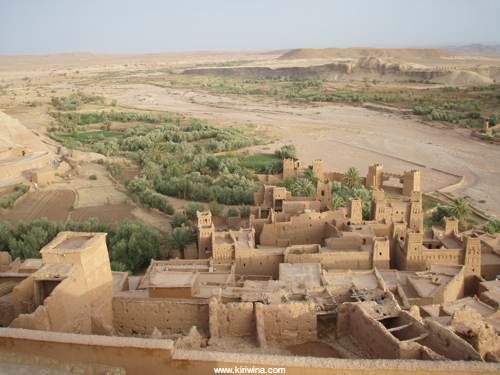
Rock formations nearby. Tomas and I both thought this landscape very similar to what we had seen in "Western" films.
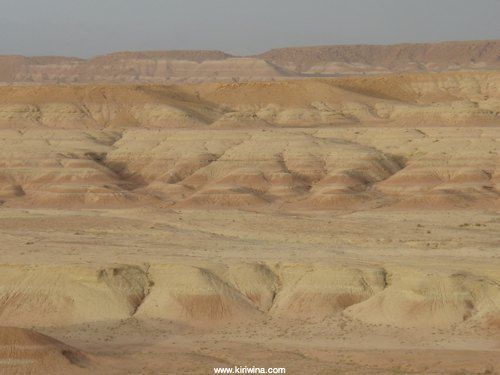
Back in Oarzazate we decided to try for a least one star. We hadn't bought any towels. Finally we chose the 3 star La Perle du Sud. Rule number 1 in Morocco always check carefully before handing over any money. Even in this 3 star hotel the first two rooms they offered were not acceptable. The third was fine.
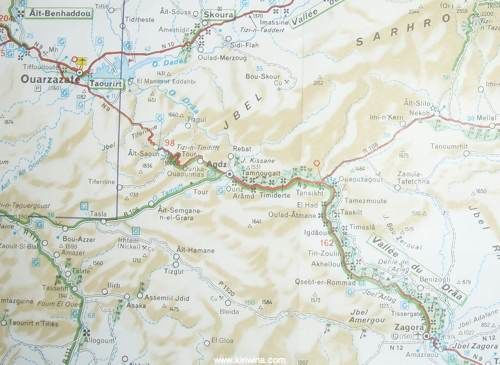
We had a coffe before heading south along the Vallée du Drâa towards Zagora. On our Michelin map it looked as though the valley was completely filled with palm plantations. It wasn't.
First we had to cross another mountain range, the Jebel Saharo. Not as high as the High Atlas but spectacular nonetheless.
Not a plant in sight. Just bleak mountains and valleys as far as we could see. It was a very long way down on the other side of this barrier.

Bleakness on a grand scale.

Looking south from the highest pass the Vallée du Drâa with it's river virtually dry and the first of the Palms in the distance.

As we passed palm plantations vendors would appear and wave boxes of dates. Their marketing strategy was often suspect as they chose locations without much space to stop and where traffic was travelling quite fast.

One of the many villages along the valley. All built in a similar style with reddish brown mudbrick.

As we approached Zagora the plantations became more extensive. In Zagora itself the hustlers started even before we had stopped the car.
On the way down we had had the car windows open to benefit from a strongish breeze. We hadn't noticed that the breeze was carrying a lot of red dust. We and the car intererior we covered in it.
There seemed little reason to linger. We had a quick drink here before returning north. Now with the windows closed and the air conditioning on.

Just outside Zagora we went for a walk through one of the plantations. These were magnificent Palm trees.

It was almost time for the date harvest. We tried some and they were delicious.

Back into the Jebel Saharo and more of the spectacular rock formations.

Looking down into a dry river bed. The few palms surviving until it rains again.

Considering the robust terrain the roads were generally quite good though not suited for high speeds.

Our little Atoz and the view south.

We returned to Oarzazate and carried on to Âit-Benhaddou a few miles to the NW. This turned out to be a hilltop village where we were told a number of films had been shot in the 80's including Indiana Jones and Jewel of the Nile.
Looking towards the village across a wide and dry river bed.

The village looked a bit twee and I wondered whether it had been built especially for filming. Apparently not, as we later saw many similar villages.

There was a 10Dhm admission into the village to fund "restoration". Once inside it seemed pretty run down, not untypical, although a path to the hilltop was being refurbished.

A view from the hilltop with the wide river bed clearly visible. In winter this becomes a fast flowing river.

Rock formations nearby. Tomas and I both thought this landscape very similar to what we had seen in "Western" films.

Back in Oarzazate we decided to try for a least one star. We hadn't bought any towels. Finally we chose the 3 star La Perle du Sud. Rule number 1 in Morocco always check carefully before handing over any money. Even in this 3 star hotel the first two rooms they offered were not acceptable. The third was fine.

To Ouarzazate
17/09/07 17:07 Filed in: Morocco
First up we had to organise a car for our trip south. For no other reason other than that we walked past we chose Location Vehicule Widad and arranged for what we were told was a new Honda.
We were to collect the car later in the afternoon.
Then we had breakfast round the corner. When the bill seemed high we discovered that the waiter had not done the maths correctly.
In the interim we did the tourist thing and took a bus tour of the city "monuments".
Central Mosque and gardens not far from our hotel.
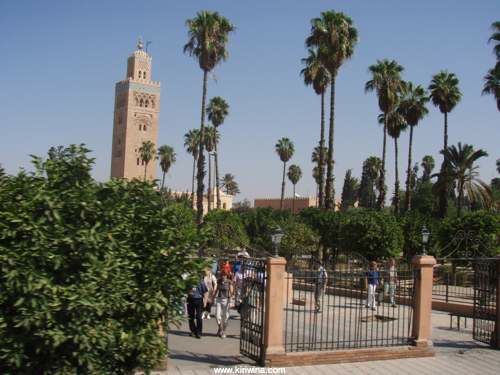
Eyes left! A view from the top deck as our bus passed a group of camels in the Palmerie just north of the city. The Palmerie, a large Palm plantation, was the only "monument" worth seeing from the tour bus.
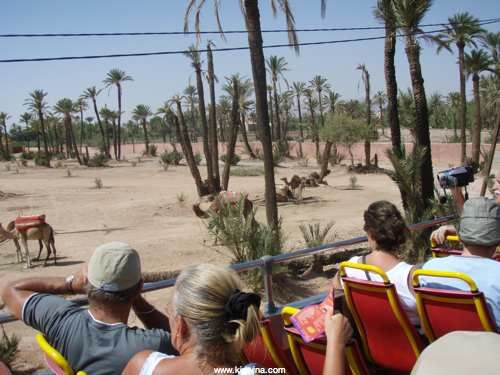
What we had in fact done was to go on a tour of most of the large Hotels (otherwise called get on get off stops) in Marrakech. There are a lot with many new ones being built. A complete waste of time and money.
Before getting the car we had a walk through the Medina where I bought another belt. The one I got last time wore out after about 20 years.
Location Vehicule Widad insisted on payment in advance. Cash! We soon found out why.
Our new Honda turned out to be a Hyundai Atos with 85,000km on the clock. I gave up trying to write down all the dents and scratches. They didn't have a damage sheet anyway. I remembered a Canadian company in Toronto called Rent-a-Wreck. An apt name for Location Vehicule Widad but we decided to keep the car. The engine ran.
With Tomas driving we made our way out of the city delayed only by a corrupt policeman who pulled us over claiming we had run a red light and demanding a "coffee" to let us go. A "coffee" actually meant 50 Dhm cash. He got his "coffee" and we went on our way to Ouarzazate about 200k SE of Marrakech.
A first the countryside was similar to what we had seen yesterday from the train but as we approached the High Atlas the scenery began to change.
Foothills of the High Atlas with fertile river valley.
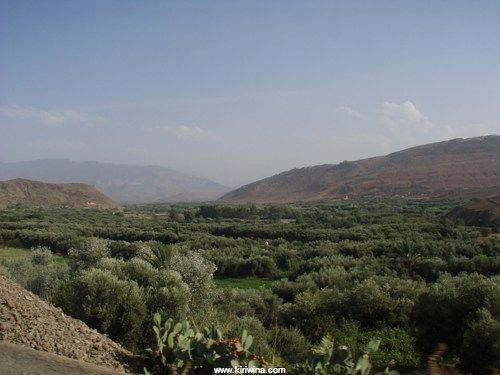
As we started to climb into the mountains we started to see roadside stalls selling fossilised rocks. Traffic was light.
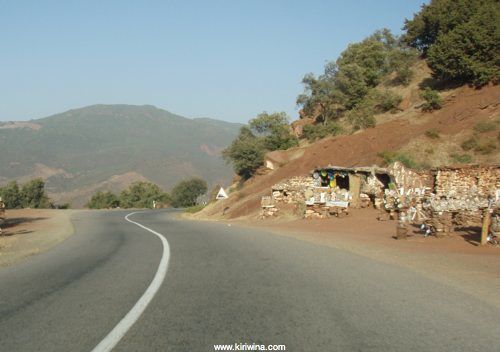
Much higher up in the High Atlas. These mountains are snow covered in winter and the roads often impassable. Now they were dry and barren. A very harsh landscape.
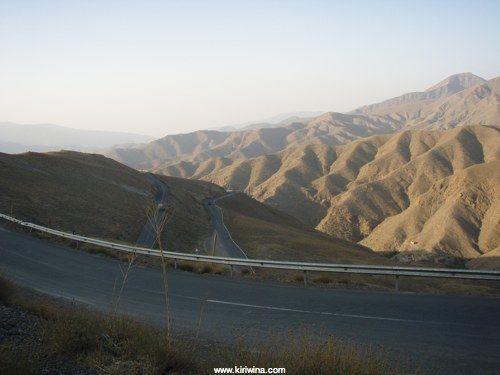
The road was very windy and often very slow. Some sections were without fencing and it was a long way down. Here we were stuck behind a petrol tanker and a Grand Taxi. Our speed at this point was about 15-20 km/h. The red and yelow pole is a snow mark.
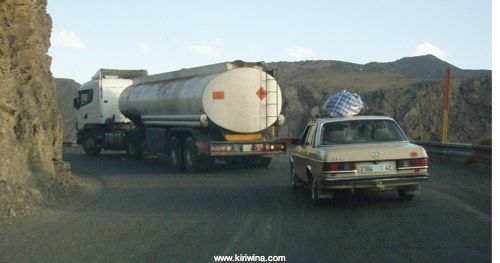
Over the top and we saw the first of many villages. Most rivers were dry or with minimal flow but the trees survived.
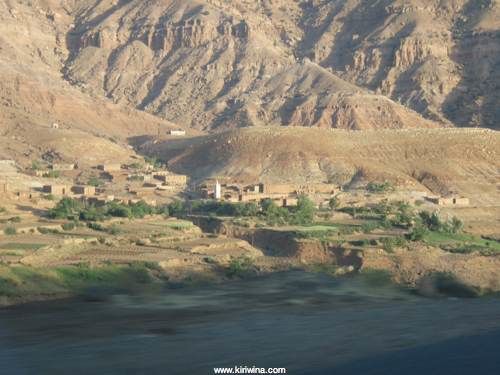
We got to Ouarzazate at 19:00 by which time it was completely dark. After looking at three no star hotels we chose one. It cost 120 Dhm( about £7.50). All the restaurants seemed to have pretty much the same menu. Later, after eating we walked for a bit.
Thisis the main square in Ouarzazate.
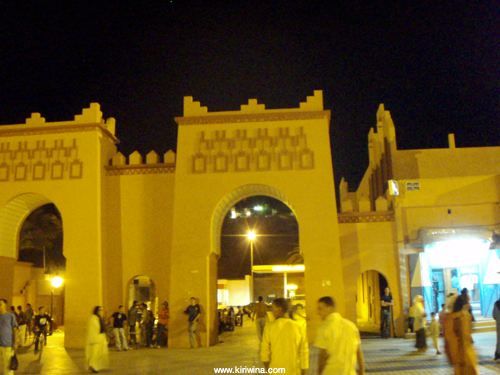
On the way back to the hotel at around 23:00 we were walking past a little shop selling artefacts from the Sahara. The owner, Hassan, wanted to chat. Then he invited us to sit down. Then he said it was getting cold and invited us inside for tea. Then he started to sell.
It had been a slow day and we were his last chance for a sale.
It was quite fun. An hour later Tomas had bought something which I am forbidden to discuss in case anyone from Extramadura is reading. (Hola Senorita C).
I was shown some silver Touareg crosses which Hassan said were used by travellers in the desert to navigate. I was sceptical but after much haggling eventually bought this. He started at 800 Dhm and we ended up at 200 Dhm.
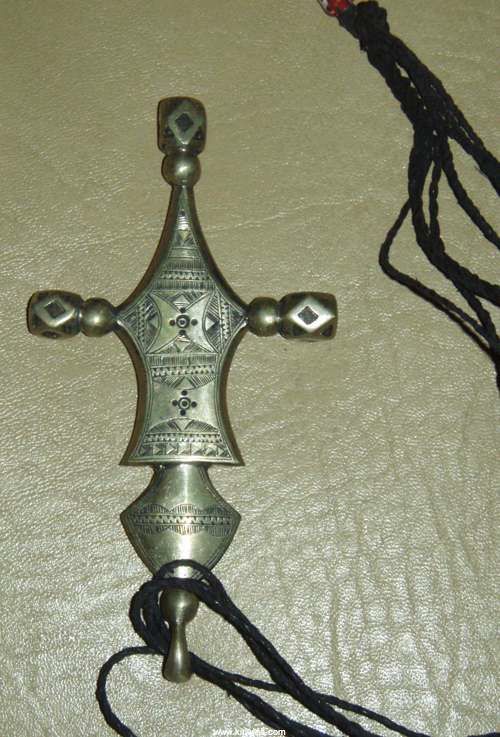
Back at the hotel we realised there were no towels. They seemed surprised when we asked.
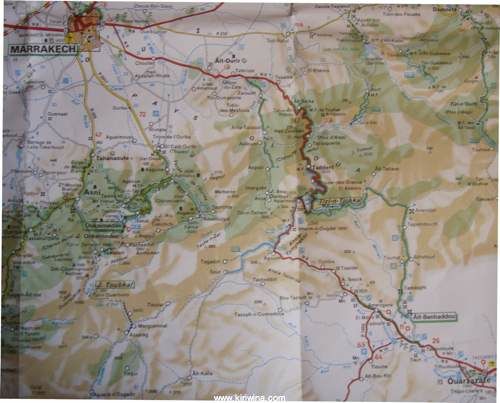
We were to collect the car later in the afternoon.
Then we had breakfast round the corner. When the bill seemed high we discovered that the waiter had not done the maths correctly.
In the interim we did the tourist thing and took a bus tour of the city "monuments".
Central Mosque and gardens not far from our hotel.

Eyes left! A view from the top deck as our bus passed a group of camels in the Palmerie just north of the city. The Palmerie, a large Palm plantation, was the only "monument" worth seeing from the tour bus.

What we had in fact done was to go on a tour of most of the large Hotels (otherwise called get on get off stops) in Marrakech. There are a lot with many new ones being built. A complete waste of time and money.
Before getting the car we had a walk through the Medina where I bought another belt. The one I got last time wore out after about 20 years.
Location Vehicule Widad insisted on payment in advance. Cash! We soon found out why.
Our new Honda turned out to be a Hyundai Atos with 85,000km on the clock. I gave up trying to write down all the dents and scratches. They didn't have a damage sheet anyway. I remembered a Canadian company in Toronto called Rent-a-Wreck. An apt name for Location Vehicule Widad but we decided to keep the car. The engine ran.
With Tomas driving we made our way out of the city delayed only by a corrupt policeman who pulled us over claiming we had run a red light and demanding a "coffee" to let us go. A "coffee" actually meant 50 Dhm cash. He got his "coffee" and we went on our way to Ouarzazate about 200k SE of Marrakech.
A first the countryside was similar to what we had seen yesterday from the train but as we approached the High Atlas the scenery began to change.
Foothills of the High Atlas with fertile river valley.

As we started to climb into the mountains we started to see roadside stalls selling fossilised rocks. Traffic was light.

Much higher up in the High Atlas. These mountains are snow covered in winter and the roads often impassable. Now they were dry and barren. A very harsh landscape.

The road was very windy and often very slow. Some sections were without fencing and it was a long way down. Here we were stuck behind a petrol tanker and a Grand Taxi. Our speed at this point was about 15-20 km/h. The red and yelow pole is a snow mark.

Over the top and we saw the first of many villages. Most rivers were dry or with minimal flow but the trees survived.

We got to Ouarzazate at 19:00 by which time it was completely dark. After looking at three no star hotels we chose one. It cost 120 Dhm( about £7.50). All the restaurants seemed to have pretty much the same menu. Later, after eating we walked for a bit.
Thisis the main square in Ouarzazate.

On the way back to the hotel at around 23:00 we were walking past a little shop selling artefacts from the Sahara. The owner, Hassan, wanted to chat. Then he invited us to sit down. Then he said it was getting cold and invited us inside for tea. Then he started to sell.
It had been a slow day and we were his last chance for a sale.
It was quite fun. An hour later Tomas had bought something which I am forbidden to discuss in case anyone from Extramadura is reading. (Hola Senorita C).
I was shown some silver Touareg crosses which Hassan said were used by travellers in the desert to navigate. I was sceptical but after much haggling eventually bought this. He started at 800 Dhm and we ended up at 200 Dhm.

Back at the hotel we realised there were no towels. They seemed surprised when we asked.

To Marrakech
16/09/07 17:06 Filed in: Morocco
We caught the 10:22 to Marrakech travelling first class. It's a worthwhile upgrade and ensures reserved seats. It really is a good rail system here.
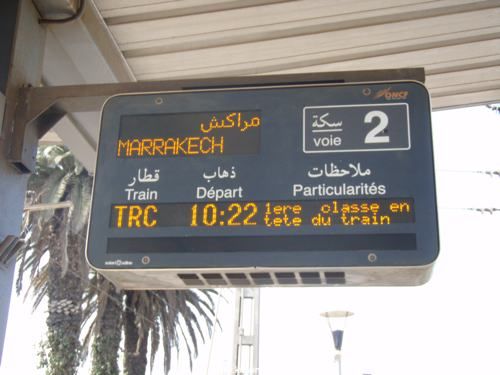
Most locomotives here are built by Alsthom in Casablanca. This one was built in Japan by Hitachi.
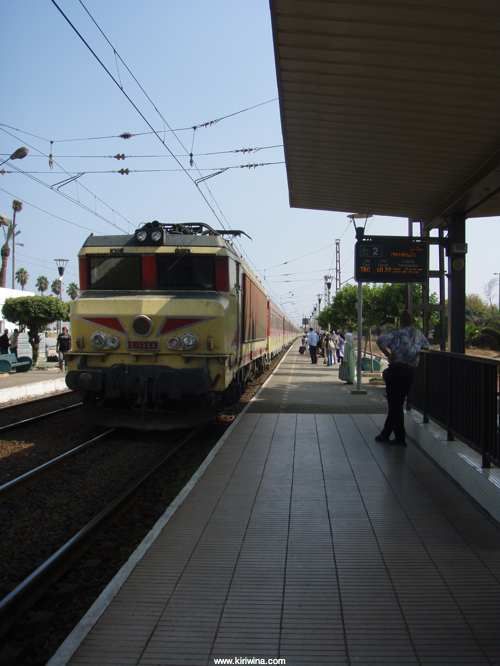
The terrain between Casablanca and Marrakech was featureless. Just flat barren rocky ground most od the time. We arrived in Marrakech at around 15:30.
I taken photos on my previous visit in 1974 and I was sure the station had changed. It will soon change again as a completely new station is under construction.
Main platform at Marrakech station.
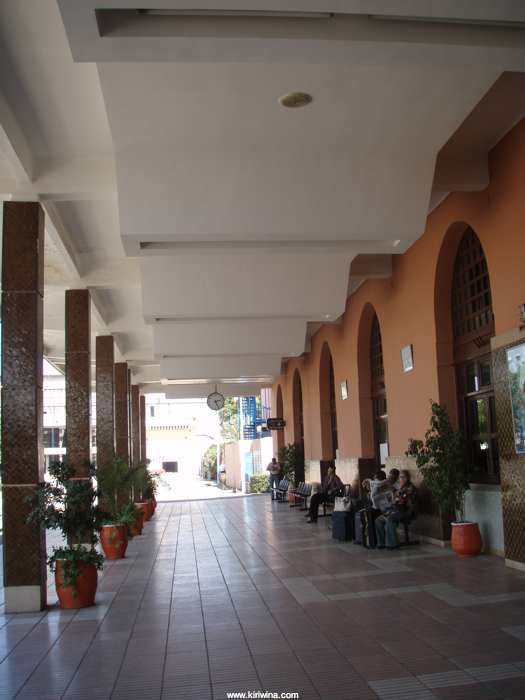
The exterior.
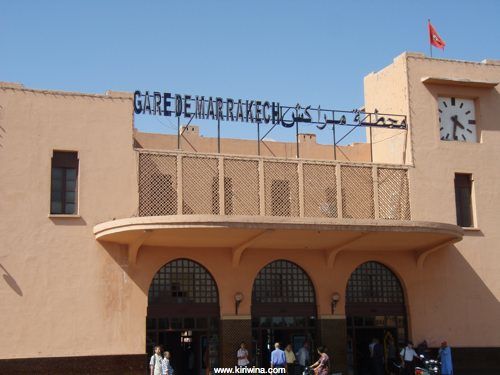
We made our way to the centre and found a small hotel for 230 Dhm It was just off the main square. Not the best of pictures but not a bad little hotel.
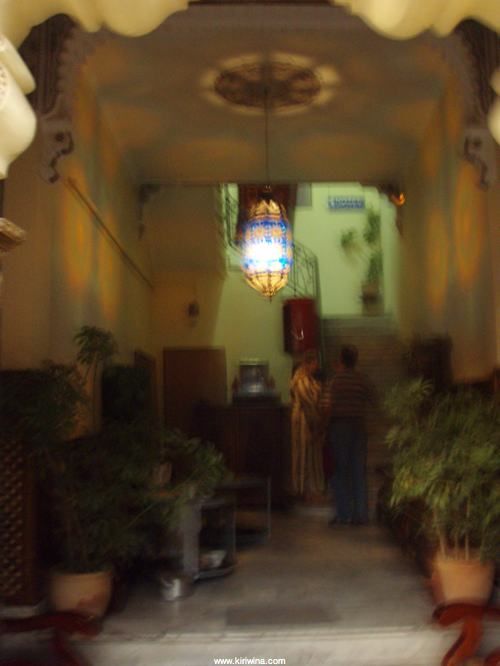
Marrakech had changed massively. The main square is now paved over and the old dynamic market has been replaced by twee little wagons all selling fruit at the same price.
The number of tourists was enormous (we of course were adding to the number). When I first came here in 1973 Marrakech had tremendous appeal and I found it very exciting. Now it appears to be just another tourist destination.
We had dinner in the main square. At night the centre is taken up by more twee little wagons surrounded by trestles. You choose your wagon and are fed. The wagons with a display of salads and fruit fed lots of of tourists (including us). The wagons which had goat or sheep heads on display didn't.
Our wagon was number 12 Bel Hadj. The food was ok but it was far more entertaining watching the Bel Hadj hustlers/waiters try to solicit custom from the passing stream of visitors.
Number 12 wagon Bel Hadj.
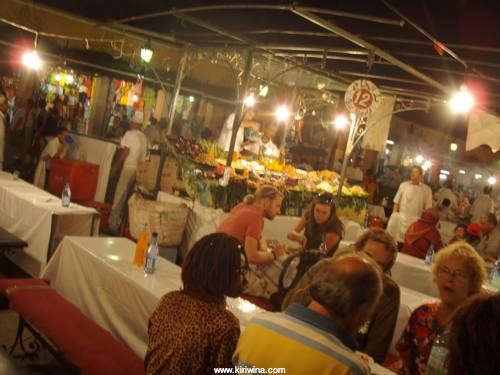
This charming 12 year old girl was doing the rounds trying to sell packets of paper hankies. She needn't have bothered with the hankies. All she needed to do was smile and people (including us) would give her a few coins for a photo.
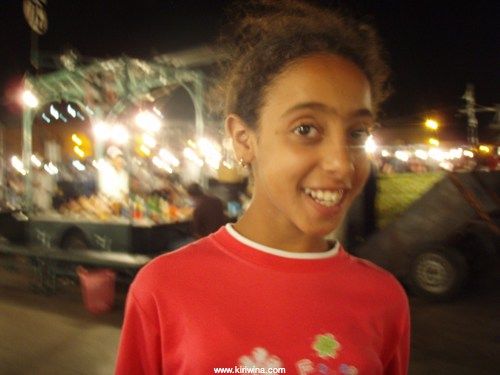
Walking around after dinner we spotted this fortune teller chatting away on her mobile. Odd how the old and the new mix. We saw may mud brick houses with satellite dishes.
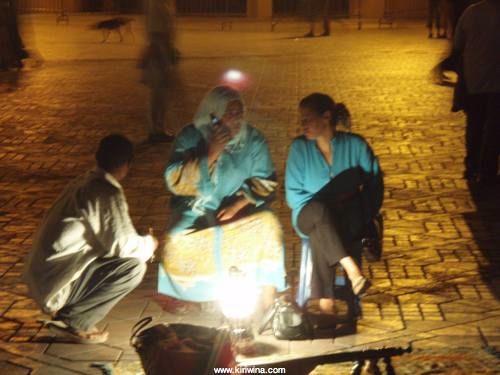
The main square at night.
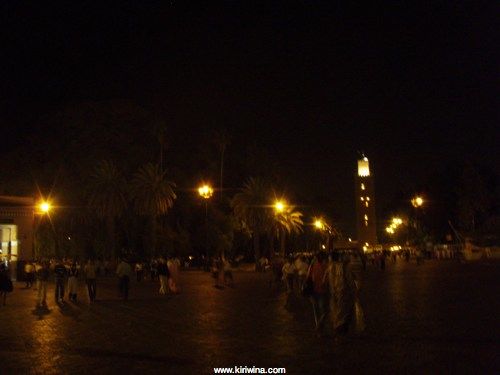

Most locomotives here are built by Alsthom in Casablanca. This one was built in Japan by Hitachi.

The terrain between Casablanca and Marrakech was featureless. Just flat barren rocky ground most od the time. We arrived in Marrakech at around 15:30.
I taken photos on my previous visit in 1974 and I was sure the station had changed. It will soon change again as a completely new station is under construction.
Main platform at Marrakech station.

The exterior.

We made our way to the centre and found a small hotel for 230 Dhm It was just off the main square. Not the best of pictures but not a bad little hotel.

Marrakech had changed massively. The main square is now paved over and the old dynamic market has been replaced by twee little wagons all selling fruit at the same price.
The number of tourists was enormous (we of course were adding to the number). When I first came here in 1973 Marrakech had tremendous appeal and I found it very exciting. Now it appears to be just another tourist destination.
We had dinner in the main square. At night the centre is taken up by more twee little wagons surrounded by trestles. You choose your wagon and are fed. The wagons with a display of salads and fruit fed lots of of tourists (including us). The wagons which had goat or sheep heads on display didn't.
Our wagon was number 12 Bel Hadj. The food was ok but it was far more entertaining watching the Bel Hadj hustlers/waiters try to solicit custom from the passing stream of visitors.
Number 12 wagon Bel Hadj.

This charming 12 year old girl was doing the rounds trying to sell packets of paper hankies. She needn't have bothered with the hankies. All she needed to do was smile and people (including us) would give her a few coins for a photo.

Walking around after dinner we spotted this fortune teller chatting away on her mobile. Odd how the old and the new mix. We saw may mud brick houses with satellite dishes.

The main square at night.

Return to Mohammedia
15/09/07 18:04 Filed in: Morocco
It's not often on this trip that I have been glad to leave a place but I was very glad to leave Fes.
Twelve seconds (I timed it) after leaving the hotel for the short walk to the station the hustlers were at it again even though we were obviously leaving.
We had an uneventful trip back on the train and ate again at the Hotel Jnane Fedala they had laid on a very nice Ramadan buffet.
Menu holder and Tomas outside the Hotel Jnane Fedala.
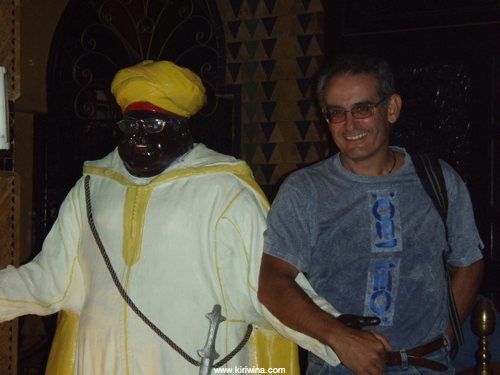
Ramadan is an odd period. At 19:00 the streets are deserted and most cafes and restaurants are empty. The Medina is virtually deserted. By 21:00 the streets are teeming, shops are open, cafes are full and the Medina is in full swing.
Twelve seconds (I timed it) after leaving the hotel for the short walk to the station the hustlers were at it again even though we were obviously leaving.
We had an uneventful trip back on the train and ate again at the Hotel Jnane Fedala they had laid on a very nice Ramadan buffet.
Menu holder and Tomas outside the Hotel Jnane Fedala.

Ramadan is an odd period. At 19:00 the streets are deserted and most cafes and restaurants are empty. The Medina is virtually deserted. By 21:00 the streets are teeming, shops are open, cafes are full and the Medina is in full swing.
To Fes
14/09/07 04:26 Filed in: Morocco
Another early morning to catch the 8:12 to Fes. It was the first day of Ramadan and the streets of Rabat were pretty much deserted.
Our train left on time. It seemed brand new and had double deck carriages.
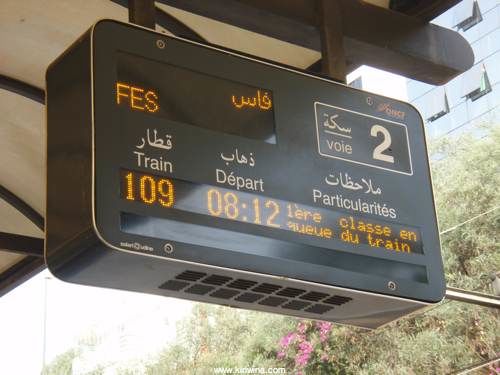
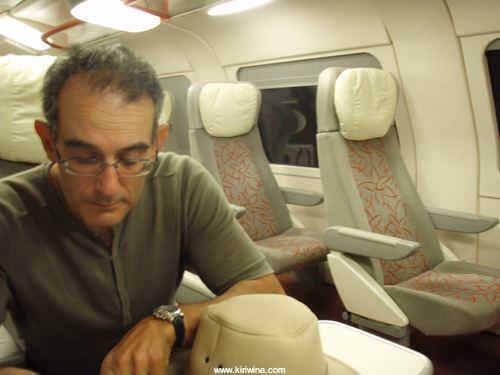
At Fes shortly after this photo was taken the hustling started. It was relentless very irritating and they would not take no for an answer.
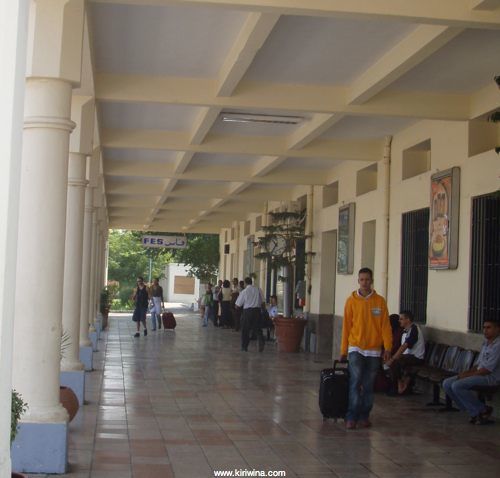
Absent a map or guide of any sort we walked for a bit and decided to check into a nearby Accor hotel. It was hot and our bags heavy.
Normally I like to find my own way round but with the tourist office being completely useless,
only providing a brochure in German, we were walking blind and exposed to continuous aggressive hustling.
If coming here again I would obtain some good maps and a "Rough Guide" before departure. Perhaps not for detail but for orientation and an overview.
Eventually we found our way to the edge of the Medina. Here the Petite taxis are red...
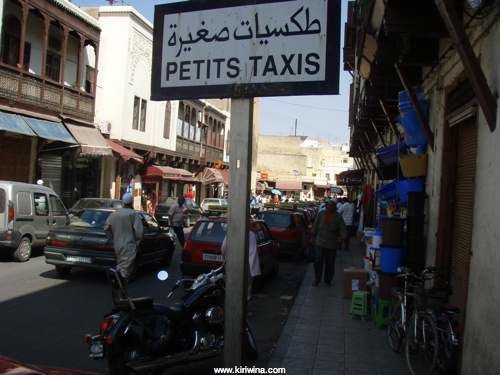
...and there are lots of them.
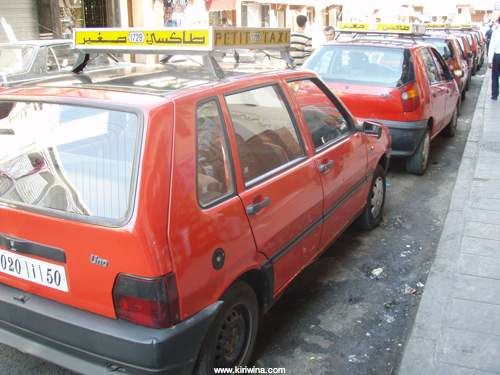
Fes is one of the four "Royal Cities in Morocco each with a palace. The others are Rabat, Meknes and Marrakech.
This picture was taken near the palace in Fes.
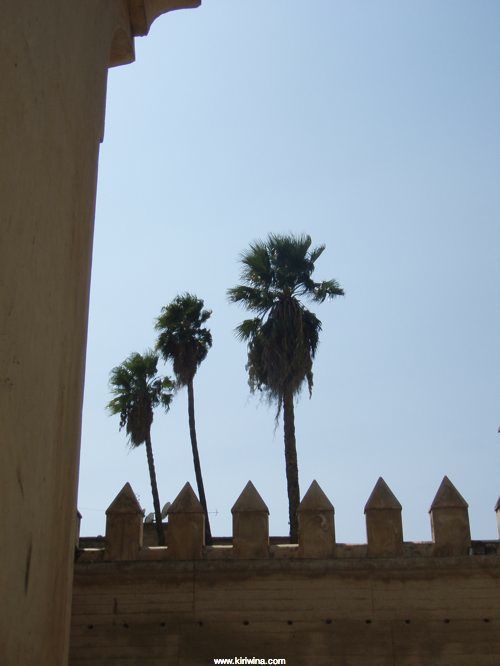
Fes has the oldest Medina in Morocco dating from circa 900.
It shows it. Many of the buildings are held up by scaffolding and are in a very poor state of repair.
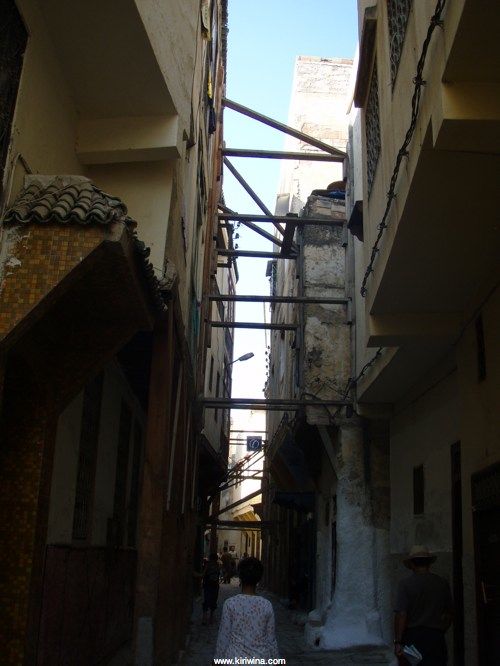
It was getting late in the afternoon and we had still not found the part of the Medina we were looking for. A chap approached us, still hustling , but in a much more subtle manner. He was a guide. We surrendered and he took us on a short tour of the Medina.
The "Blue" gate Medina entrance.
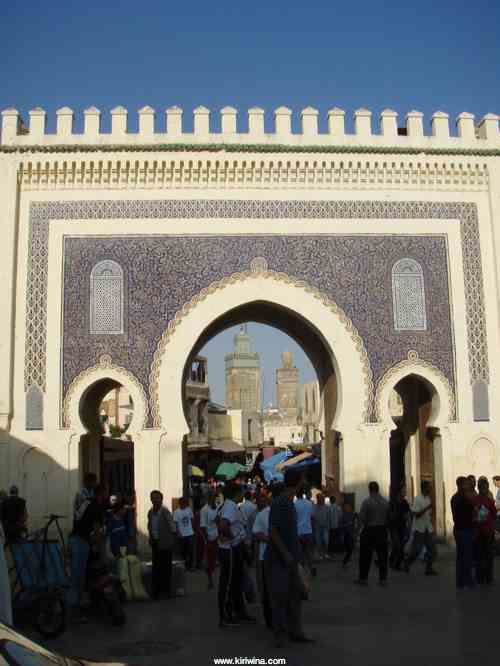
Someone important is buried here. I forget who. Only Moslems are permited entry. We were allowed a peek.
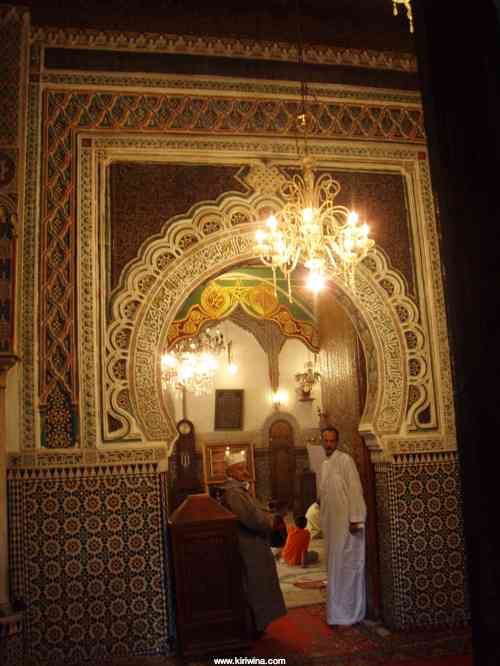
No vehicles in the Medina. Only donkeys or people can transport goods.
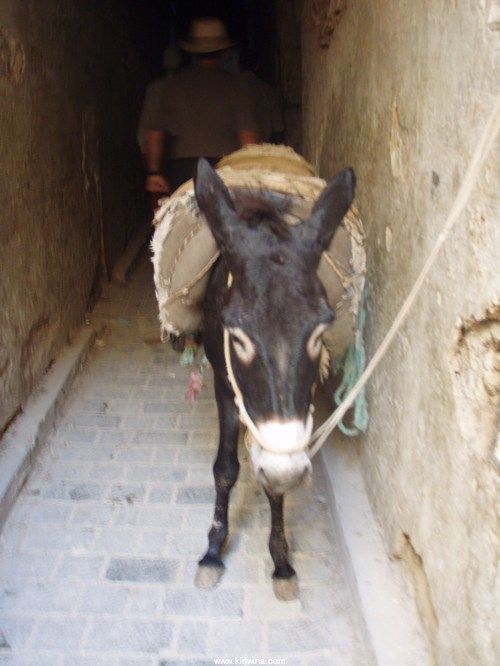
Fabrics are still hand woven on looms. The colours were stunning.
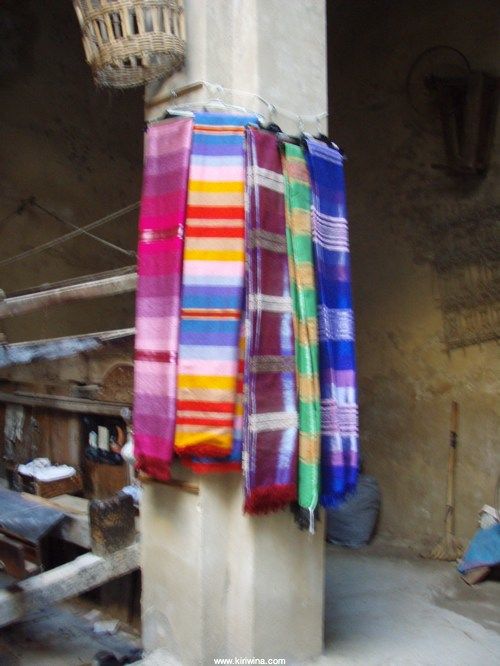
The tanneries where leather and fabrics are dyed.
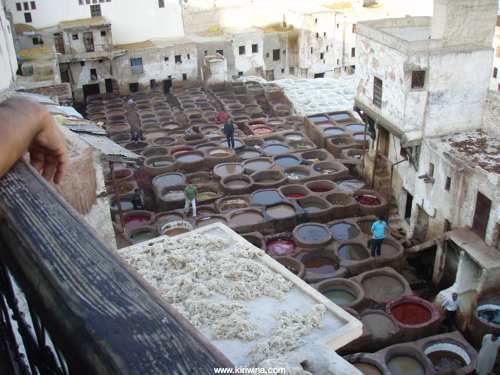
These vats are used to clean material before beginning the dyeing process.
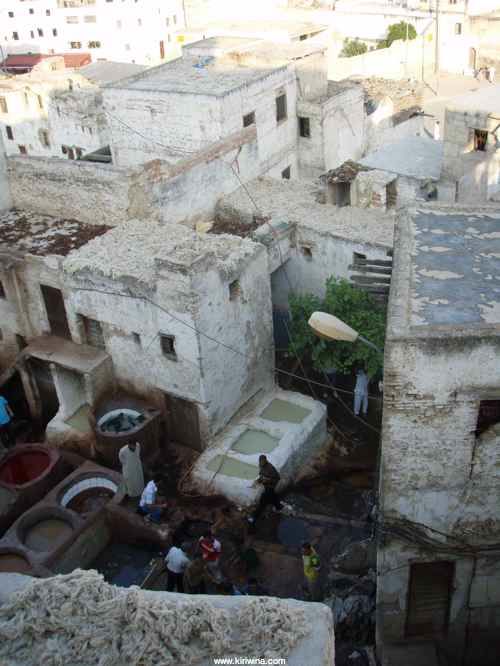
We were told this process has not changed for centuries.
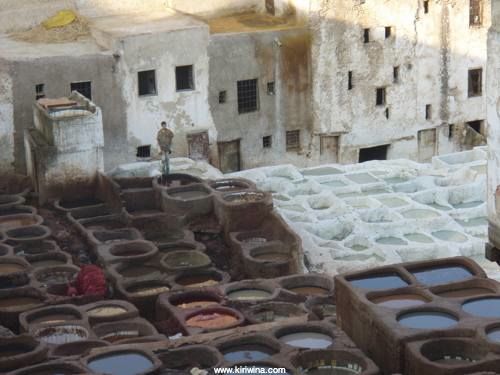
Our guide then took us to a lookout point above the Medina from where this picture of Fes was taken.
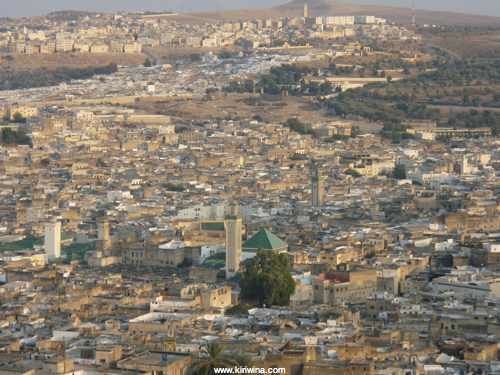
He returned us to the hotel. It had been a long hot day. Later we went out for a quick meal and inevitably more hustling.
I must say that, one or two of the spots we visited apart, I disliked Fes intensely. It was very dirty, particularly in the Medina. Raw sewage leaked onto the alleys in places, there was rubbish everywhere and the built environment seemed in very poor condition. A lot of people were packed into a small place. It was very, very crowded with large numbers of young men without very much to do. We saw three street fights in a period of two hours in the Medina.
There was an air of menace about the place I had not felt elsewhere in Morocco. The relentless hustling was irritating in the extreme and never stopped even when we had the guide.
A horrible place and IMHO to be avoided like the plague.

Our train left on time. It seemed brand new and had double deck carriages.


At Fes shortly after this photo was taken the hustling started. It was relentless very irritating and they would not take no for an answer.

Absent a map or guide of any sort we walked for a bit and decided to check into a nearby Accor hotel. It was hot and our bags heavy.
Normally I like to find my own way round but with the tourist office being completely useless,
only providing a brochure in German, we were walking blind and exposed to continuous aggressive hustling.
If coming here again I would obtain some good maps and a "Rough Guide" before departure. Perhaps not for detail but for orientation and an overview.
Eventually we found our way to the edge of the Medina. Here the Petite taxis are red...

...and there are lots of them.

Fes is one of the four "Royal Cities in Morocco each with a palace. The others are Rabat, Meknes and Marrakech.
This picture was taken near the palace in Fes.

Fes has the oldest Medina in Morocco dating from circa 900.
It shows it. Many of the buildings are held up by scaffolding and are in a very poor state of repair.

It was getting late in the afternoon and we had still not found the part of the Medina we were looking for. A chap approached us, still hustling , but in a much more subtle manner. He was a guide. We surrendered and he took us on a short tour of the Medina.
The "Blue" gate Medina entrance.

Someone important is buried here. I forget who. Only Moslems are permited entry. We were allowed a peek.

No vehicles in the Medina. Only donkeys or people can transport goods.

Fabrics are still hand woven on looms. The colours were stunning.

The tanneries where leather and fabrics are dyed.

These vats are used to clean material before beginning the dyeing process.

We were told this process has not changed for centuries.

Our guide then took us to a lookout point above the Medina from where this picture of Fes was taken.

He returned us to the hotel. It had been a long hot day. Later we went out for a quick meal and inevitably more hustling.
I must say that, one or two of the spots we visited apart, I disliked Fes intensely. It was very dirty, particularly in the Medina. Raw sewage leaked onto the alleys in places, there was rubbish everywhere and the built environment seemed in very poor condition. A lot of people were packed into a small place. It was very, very crowded with large numbers of young men without very much to do. We saw three street fights in a period of two hours in the Medina.
There was an air of menace about the place I had not felt elsewhere in Morocco. The relentless hustling was irritating in the extreme and never stopped even when we had the guide.
A horrible place and IMHO to be avoided like the plague.

To Rabat
13/09/07 11:21 Filed in: Morocco
Up early (06:30) as we have a train to catch to Rabat. Security is pretty tight here. Even the showers are locked overnight. This is probably the most secure marina I have ever stayed in.
We caught a Petit Taxi just outside the dock gates. There are two types of taxi here. Petit Taxis, usually aging Fiat Unos or similar painted turquoise, and Grand Taxis always aging Mercedes painted cream. Petit Taxis whiz you around town and Grand Taxis take you to another town.
It only took a few minutes to the station and cost Drm 10. We were well early for our train and caught an earlier one (The Marrakech Express) to Rabat. Cost Drm 23 each. The trip took about 45 minutes.
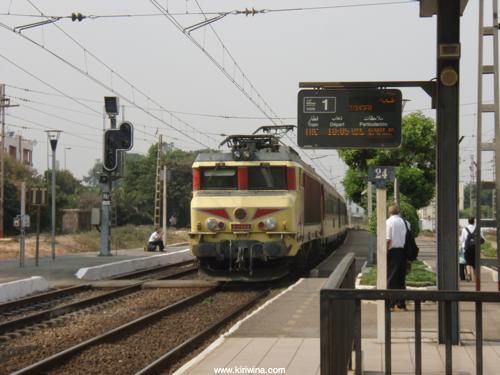
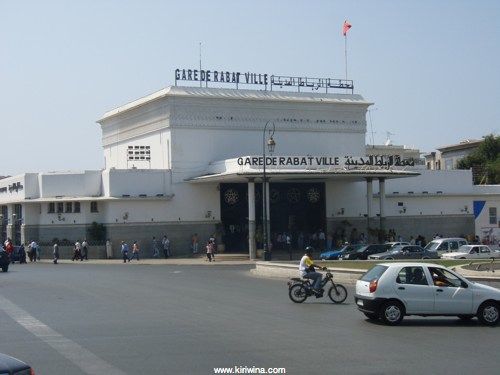
Trying to make our way to the tourist office we took a Petit Taxi. The driver misunderstood and delivered us to the Ministere du Tourisme. Never mind. They gave us some maps and brochures and sent us on our way.
This is how to do a Palm lined avenue.
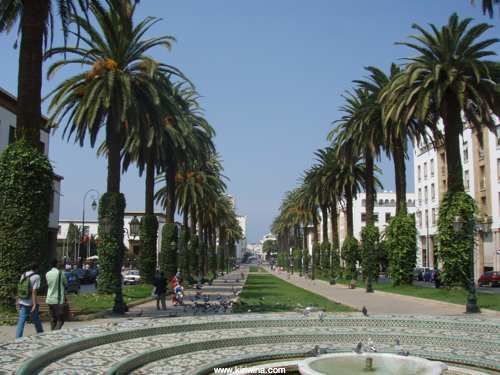
Tiling in a dry fountain.
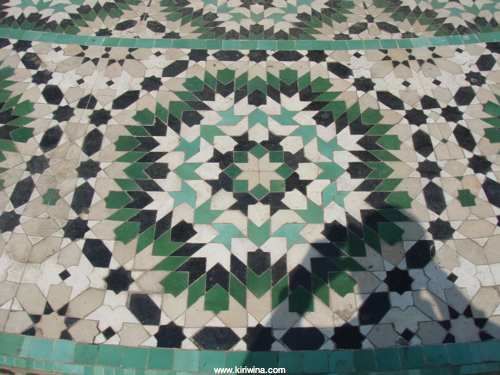
I'm getting to quite like palm trees.
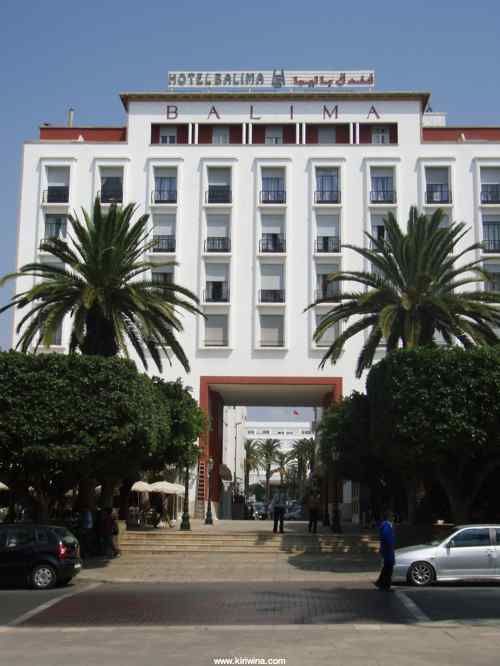
We looked at a couple of hotels before selecting the Hotel Splendide. A little less splendid than it once might have been but very central and cheap.
Then we set off on a circular walk, first to the Medina. A huge grid of narrow alleys where it was possible to buy pretty much anything.
After coming out of the Medina we walked along the waterfront to the Kasbah des Oudayas, the oldest part of Rabat and mainly residential.
A surf club on route.
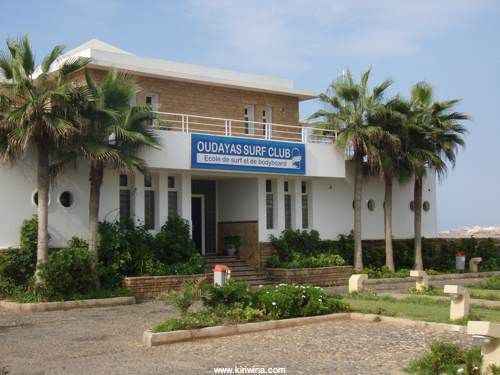
Approaching the Kasbah.
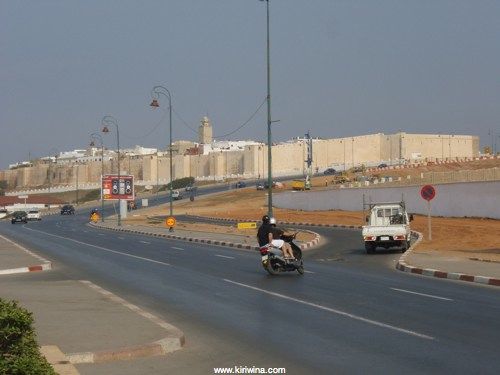
Artefacts from an archeological dig near the Kasbah.
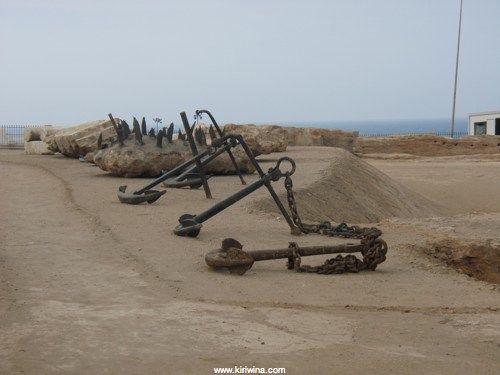
Southern wall of the Kasbah.
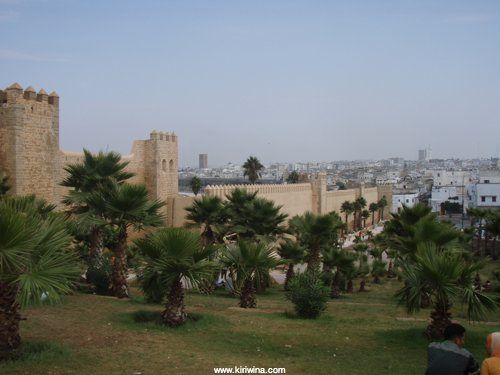
Pictures from the Kasbah. Note the colours.
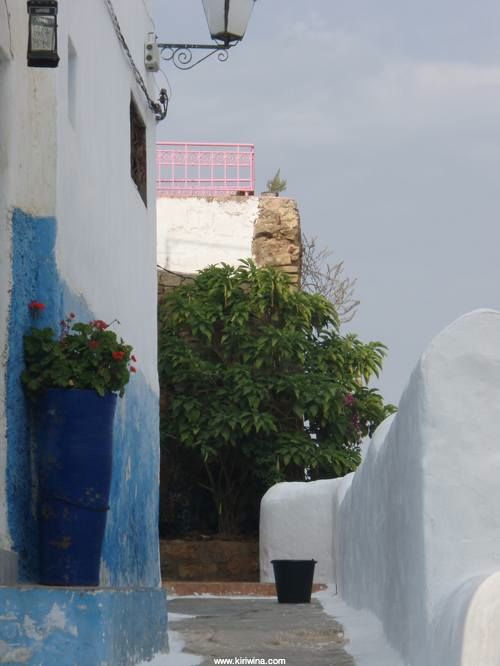
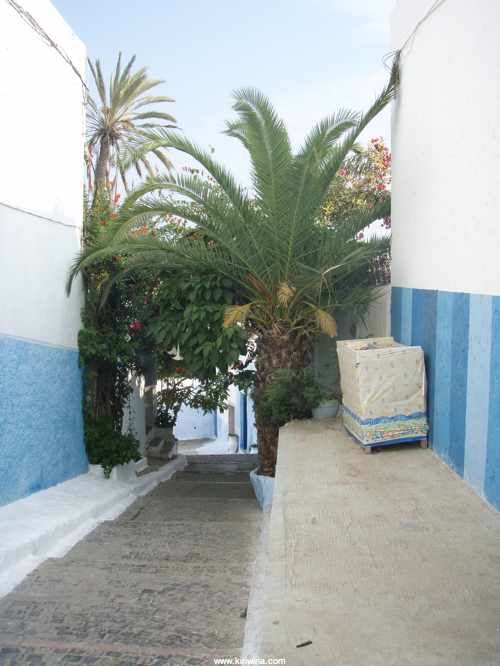
An old house in the Kasbah....
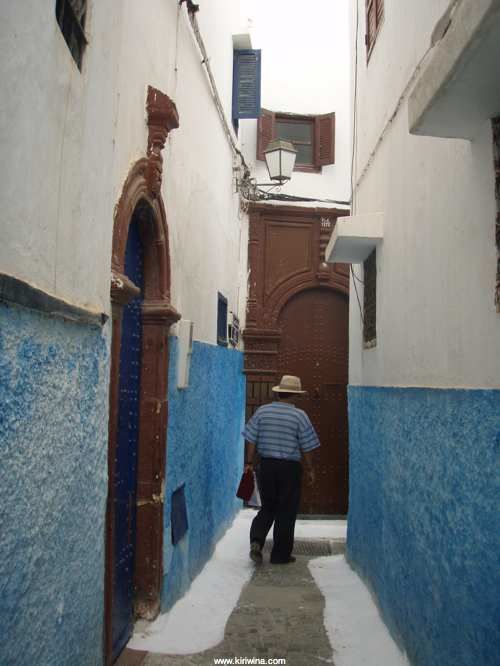
....dating from 1378?
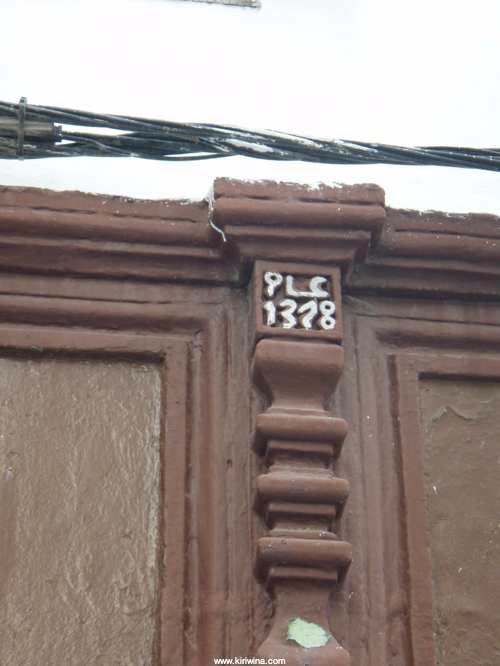
Doorway to an expensive house overlooking the river.
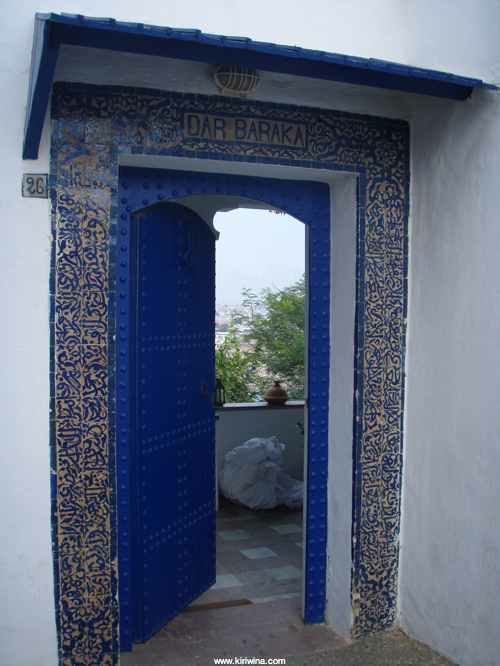
A river view.
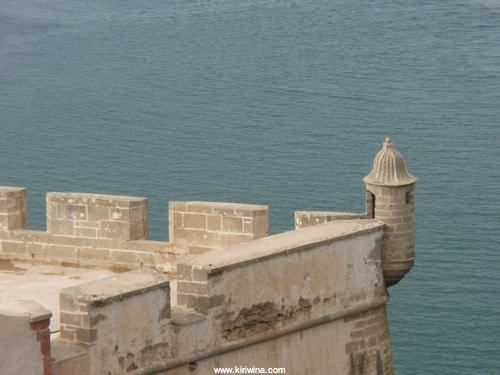
The blue theme is repeated throughout the Kasbah.
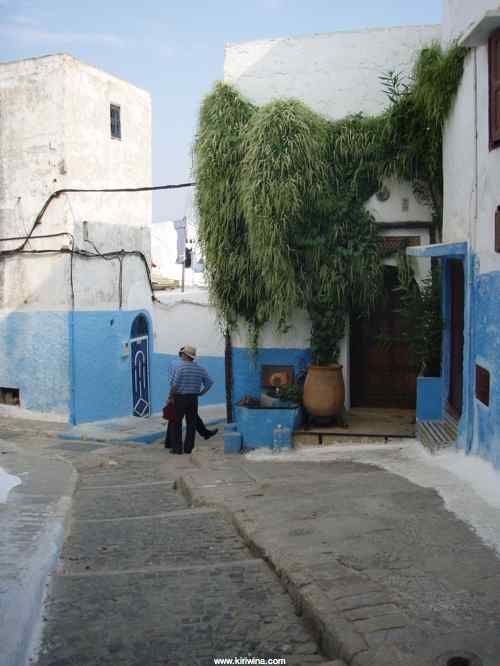
The kasbah included the Jardin Andaluces.
Entrance to Jardin Andaluces.
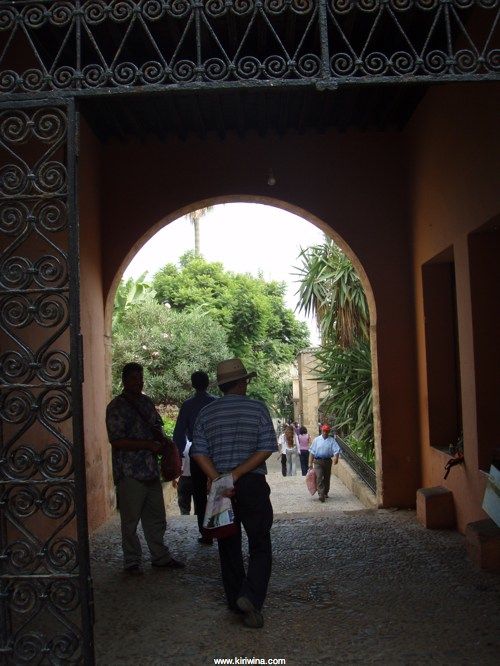
Inside the garden.
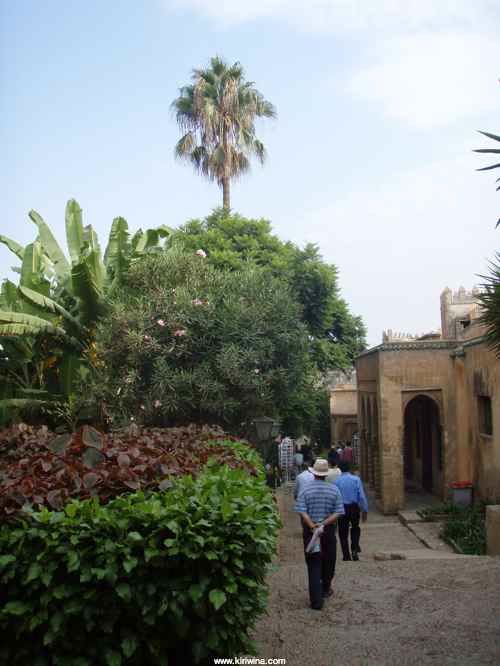
More Garden.
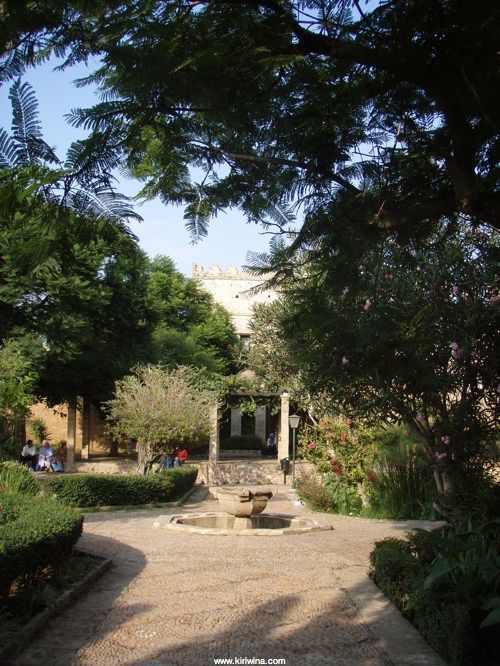
Exiting the Kasbah went back into a different section of the Medina. I couldn't resist a colourful mat for the boat to cover our B&Q floormats. Nothing is priced. You ask and are given a price which you refuse.Then a long conversation starts at the end of which you may or may not have purchased something. This does not make for rapid shopping.
Medina street.
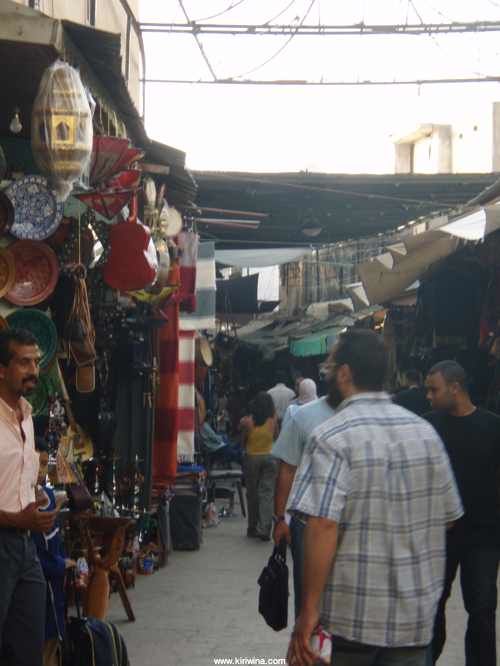
Rugs and Mirrors
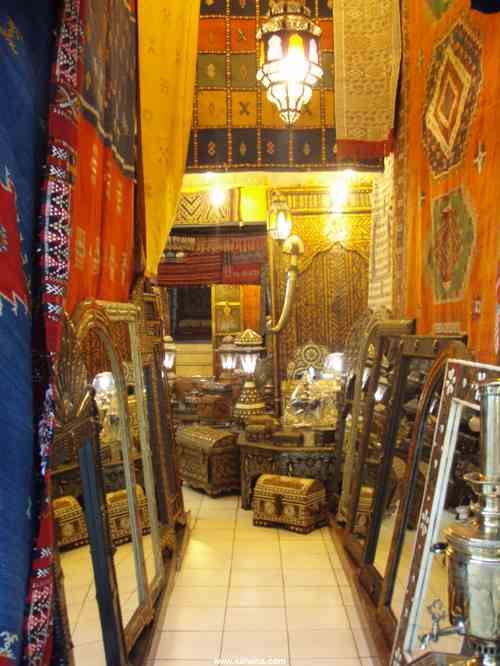
A courtyard in the Medina fabric section.
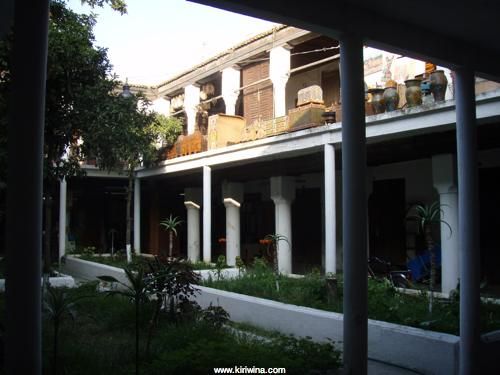
A bit further along I found a little rucksack I liked. After a long conversation I did not buy it. A bit further along I found another. This time, after an hour, I became the proud owner of a new leather rucksack.
A shoemaker at work near where I bought the rucksack.
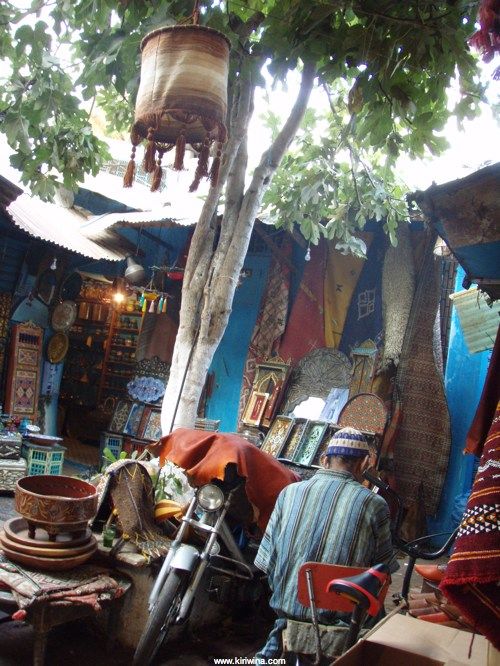
Most of the medina is sheltered from the sun. Often using woven branches as here.
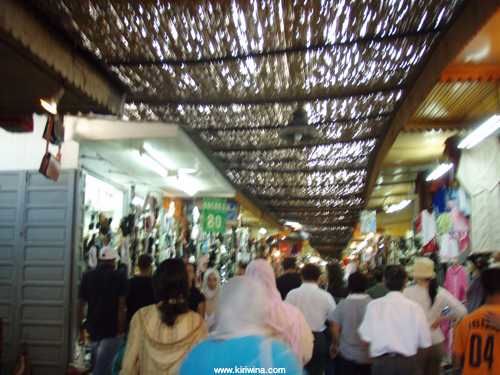
Then we exited the Medina and took a Petit Taxi to Tour Hassan. Some 44 metres high it was intended, when built in the 12th century, to reach 88 metres. Its originator Sultan Yacoub el Mansour wanted to build the biggest mosque in the world. He failed but 200 columns on which the mosques was to stand fill the esplanade adjacent to Tour Hassan.
Tour Hassan and the columns.
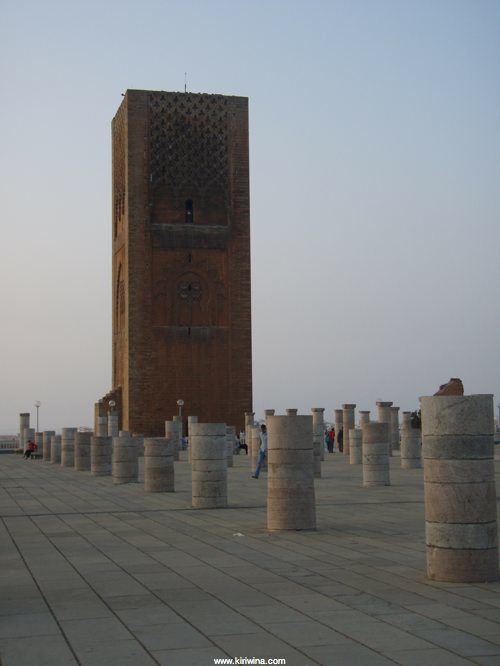
Sunset over the columns.
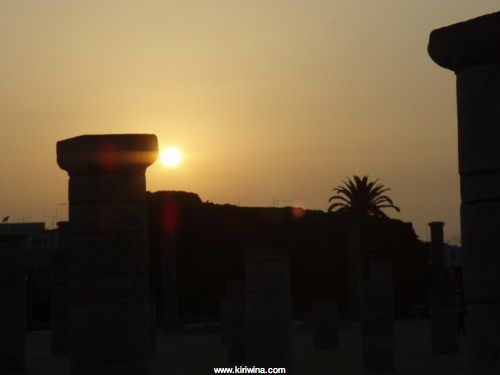
At the other end of the esplanade is the Mohammed V Mausoleum. A sumptuous monument to the Sultan who led Morocco to independance. It was closed and we were only able to see the exterior.
Mohammed V Mausoleum...
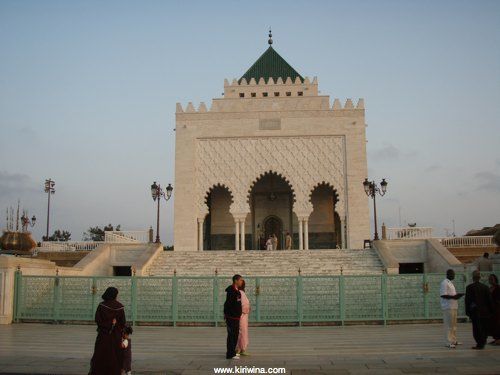
....and the Imperial guards?
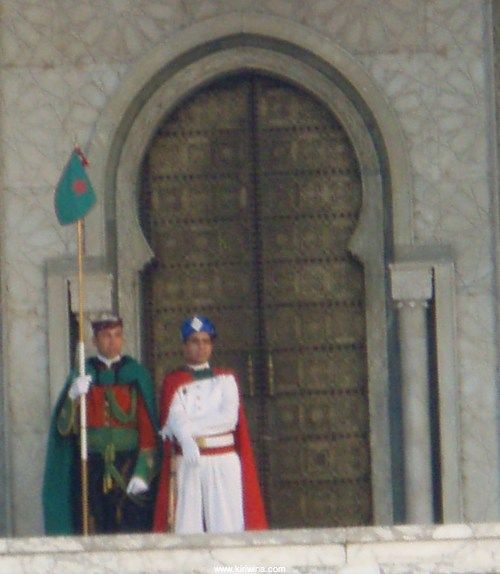
A longer view including the columns.
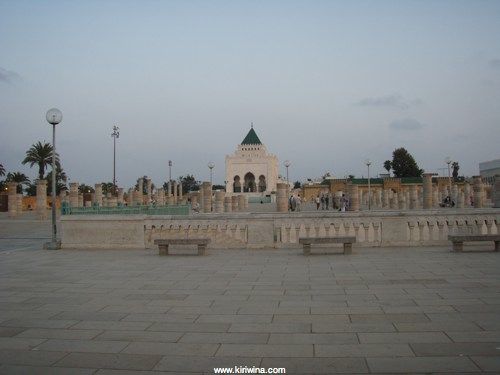
Extensive redevelopment at the river mouth in Rabat.
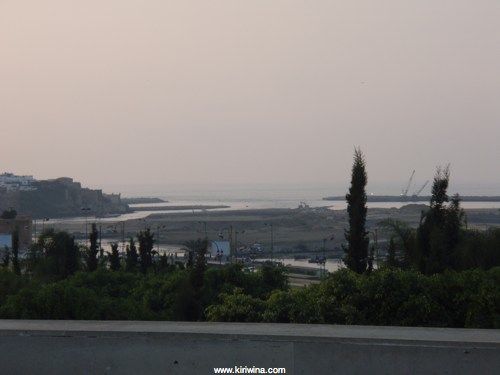
A new marina looks pretty well finished. Once the river is dredged and the redevelopment completed it shoud be possible to visit Rabat by yacht.
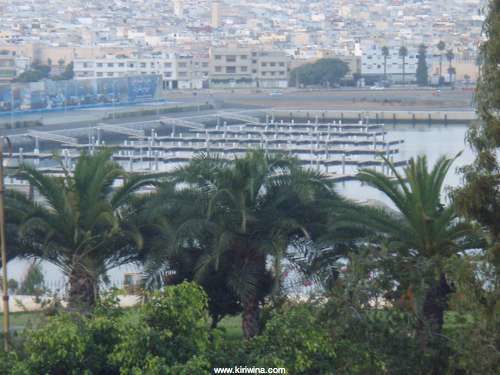
I've no idea what this flower is but they look lovely and we saw a lot in Rabat.
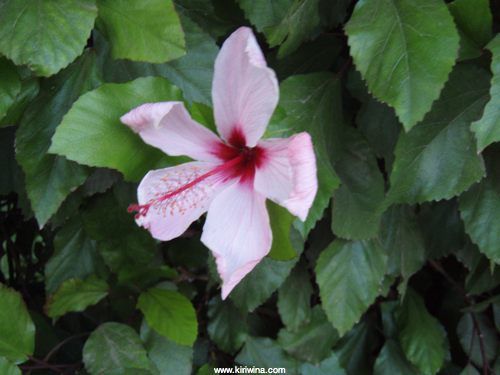

We caught a Petit Taxi just outside the dock gates. There are two types of taxi here. Petit Taxis, usually aging Fiat Unos or similar painted turquoise, and Grand Taxis always aging Mercedes painted cream. Petit Taxis whiz you around town and Grand Taxis take you to another town.
It only took a few minutes to the station and cost Drm 10. We were well early for our train and caught an earlier one (The Marrakech Express) to Rabat. Cost Drm 23 each. The trip took about 45 minutes.


Trying to make our way to the tourist office we took a Petit Taxi. The driver misunderstood and delivered us to the Ministere du Tourisme. Never mind. They gave us some maps and brochures and sent us on our way.
This is how to do a Palm lined avenue.

Tiling in a dry fountain.

I'm getting to quite like palm trees.

We looked at a couple of hotels before selecting the Hotel Splendide. A little less splendid than it once might have been but very central and cheap.
Then we set off on a circular walk, first to the Medina. A huge grid of narrow alleys where it was possible to buy pretty much anything.
After coming out of the Medina we walked along the waterfront to the Kasbah des Oudayas, the oldest part of Rabat and mainly residential.
A surf club on route.

Approaching the Kasbah.

Artefacts from an archeological dig near the Kasbah.

Southern wall of the Kasbah.

Pictures from the Kasbah. Note the colours.


An old house in the Kasbah....

....dating from 1378?

Doorway to an expensive house overlooking the river.

A river view.

The blue theme is repeated throughout the Kasbah.

The kasbah included the Jardin Andaluces.
Entrance to Jardin Andaluces.

Inside the garden.

More Garden.

Exiting the Kasbah went back into a different section of the Medina. I couldn't resist a colourful mat for the boat to cover our B&Q floormats. Nothing is priced. You ask and are given a price which you refuse.Then a long conversation starts at the end of which you may or may not have purchased something. This does not make for rapid shopping.
Medina street.

Rugs and Mirrors

A courtyard in the Medina fabric section.

A bit further along I found a little rucksack I liked. After a long conversation I did not buy it. A bit further along I found another. This time, after an hour, I became the proud owner of a new leather rucksack.
A shoemaker at work near where I bought the rucksack.

Most of the medina is sheltered from the sun. Often using woven branches as here.

Then we exited the Medina and took a Petit Taxi to Tour Hassan. Some 44 metres high it was intended, when built in the 12th century, to reach 88 metres. Its originator Sultan Yacoub el Mansour wanted to build the biggest mosque in the world. He failed but 200 columns on which the mosques was to stand fill the esplanade adjacent to Tour Hassan.
Tour Hassan and the columns.

Sunset over the columns.

At the other end of the esplanade is the Mohammed V Mausoleum. A sumptuous monument to the Sultan who led Morocco to independance. It was closed and we were only able to see the exterior.
Mohammed V Mausoleum...

....and the Imperial guards?

A longer view including the columns.

Extensive redevelopment at the river mouth in Rabat.

A new marina looks pretty well finished. Once the river is dredged and the redevelopment completed it shoud be possible to visit Rabat by yacht.

I've no idea what this flower is but they look lovely and we saw a lot in Rabat.


Kenitra to Mohammedia
12/09/07 15:20 Filed in: Morocco
12th September 2007
We left Kenitra at 14:15, 15 minutes after arriving and something of a record. Our shortest ever stay in a port.
Progress down river was slower against the flood tide. We had an uneventful trip taking just over three hours to clear the River Sebou.
A small bulk carrier, typical of the size that use the port, proceeding up river to Kenitra.
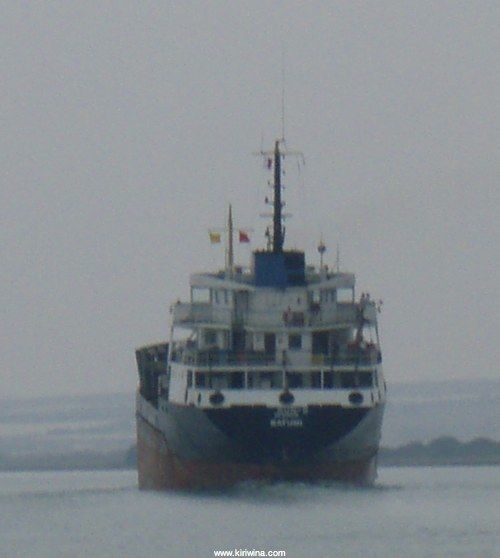
Once clear of the harbour at 17:20 we were able to sail at about three knots. We were in no hurry. Mohammedia was 40 miles away and we planned a slow overnight trip to arrive around 09:00.
This happy state of affairs lasted for two hours until the wind died completely at 19:30
Thereafter we motored on much reduced revs throughout the night.
12th September 2007
The sea was very calm and with a gentle offshore breeze we could smell Africa. It was a lovely sunrise.
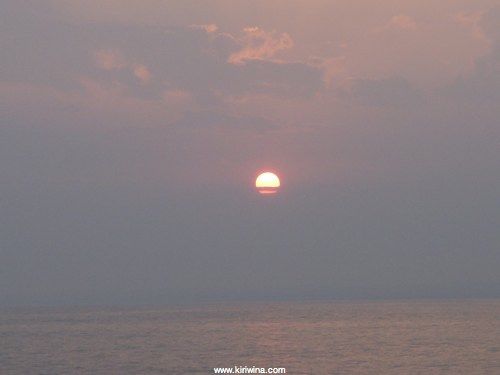
We entered Mohammedia harbour at 09:45 and were all fast at #2 pontoon, Yacht Club du Maroc - Mohammedia by 10:05.
Two types of police and a customs officer visited the boat. All were very friendly and helpful. Formalities were completed and pratique granted at 11:00 or 09:00 after adjusting for local time.
The water in the marina was very clear and the propellor was visible for the first time since Portugal.
This mess was wrapped around the propellor and explains the recent extra vibration and poor performance under engine.
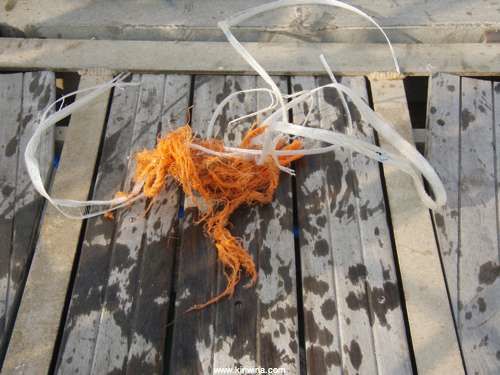
King Mohammed V Park in Mohmmedia
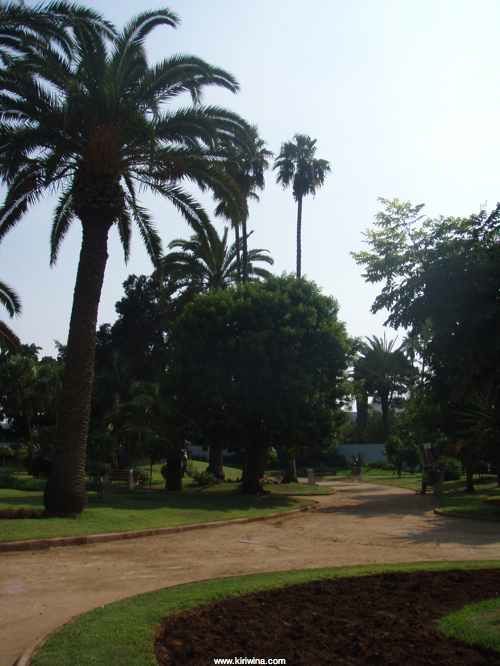
It is a lovely park situated across the road from the train station and much used with many shaded areas.
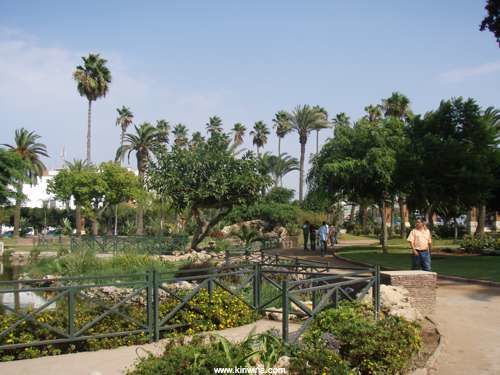
The internet cafe we used in the Medina at Mohammedia. I loved the name. "Espace Internet Kasbah".
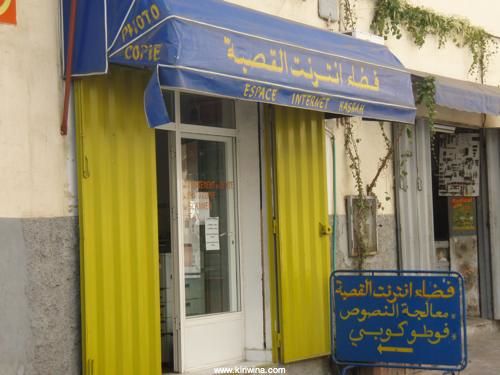
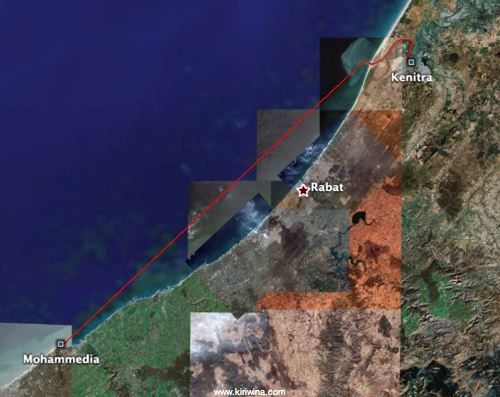
We left Kenitra at 14:15, 15 minutes after arriving and something of a record. Our shortest ever stay in a port.
Progress down river was slower against the flood tide. We had an uneventful trip taking just over three hours to clear the River Sebou.
A small bulk carrier, typical of the size that use the port, proceeding up river to Kenitra.

Once clear of the harbour at 17:20 we were able to sail at about three knots. We were in no hurry. Mohammedia was 40 miles away and we planned a slow overnight trip to arrive around 09:00.
This happy state of affairs lasted for two hours until the wind died completely at 19:30
Thereafter we motored on much reduced revs throughout the night.
12th September 2007
The sea was very calm and with a gentle offshore breeze we could smell Africa. It was a lovely sunrise.

We entered Mohammedia harbour at 09:45 and were all fast at #2 pontoon, Yacht Club du Maroc - Mohammedia by 10:05.
Two types of police and a customs officer visited the boat. All were very friendly and helpful. Formalities were completed and pratique granted at 11:00 or 09:00 after adjusting for local time.
The water in the marina was very clear and the propellor was visible for the first time since Portugal.
This mess was wrapped around the propellor and explains the recent extra vibration and poor performance under engine.

King Mohammed V Park in Mohmmedia

It is a lovely park situated across the road from the train station and much used with many shaded areas.

The internet cafe we used in the Medina at Mohammedia. I loved the name. "Espace Internet Kasbah".


Across to Africa
11/09/07 16:14 Filed in: Cadiz to Kenitra 9-11 September 2007
9th September 2007
Up very early (06:00) for final preparations before leaving Cadiz at 08:00.
At first we had favourable but light winds and made slow progress with all sails up. As the day day progressed the wind veered from SE to W while maintaining F2-3. By Midnight we had covered only 28 miles.
During the night we saw a lot of Moroccan fishing boats and the VHF was alive with repeated calls from their skippers asking big ships to avoid crossing over nets.
There was also a steady stream of ships heading to or from the Strait of Gibraltar.
10th September 2007
Determined to avoid motoring we continued to sail at snails pace as the wind hovered around force 2 between S and NW. At 09:30 the foresails were furled and we deployed the ghosting genoa. By noon our mileage from Cadiz was 40.
At 14:00 with barely any wind we surrendered and put the engine on and motorsailed. At least we were making some progress.
At midnight our trip mileage was 80.
11th September 2007
During the early hours the sea was flat calm. As the morning progressed heavy rain set in and we could see the coast of Morocco.
A small bird hitching a lift in heavy rain with small Moroccan fishing boats in the background.
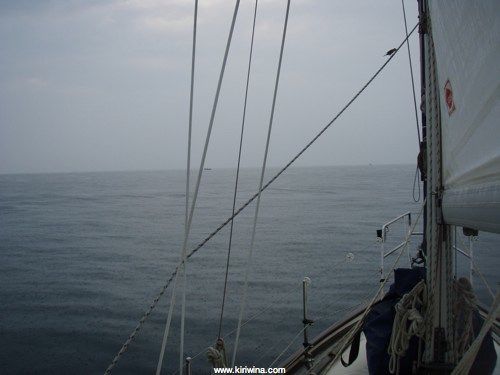
On Kenitra, the 2 year old pilot book commented "..is consequently very quiet, safe, and clean". So we chose Kenitra as our first port in Morocco.
At 11:45 we arrived off the entrance to the River Sebou where we dropped the main and proceeded in.
Old fort above the port of Mehdia at the entrance to the River Sebou
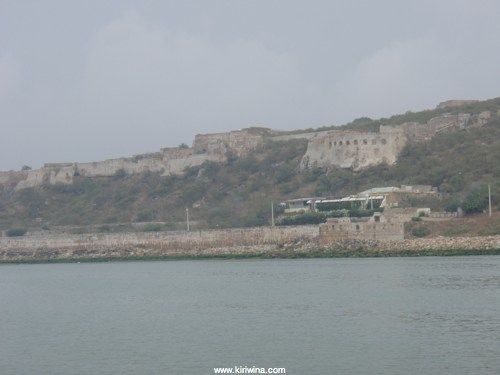
It was about 4 hours before highwater and we had to be careful to stay on the leads. Unfortunately these were difficult to identify and the GPS display showed us proceeding on dry land. Our Navionics chart was less than a year old and our Spanish paper charts were purchased less than two weeks ago. They were not a lot of help.
At 12:20 we kissed the muddy bottom at the edge of the shallows called Les Tables. We had been unable to spot the leads and wandered a tad too far to starboard.
After about 10 minutes the rising tide floated us off and we continued. The best policy was to stick pretty much to the middle but from then on we found most of the leads and followed a large fishing boat when we didn't.
Our GPS track.
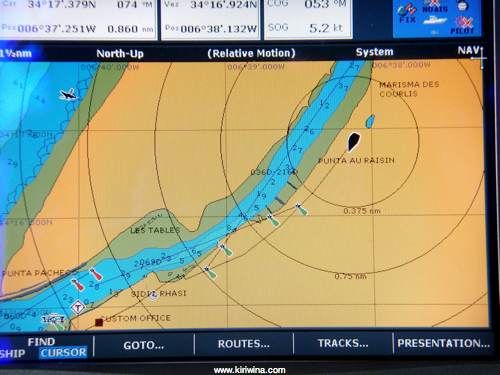
A lower lead on the River Sebou. The bush to the left helpfully obscures the lead until one is almost abeam.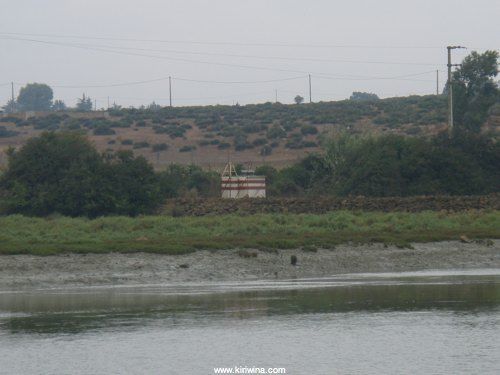
This buoy, marking a wreck, looks as though it is struggling to stay afloat itself.
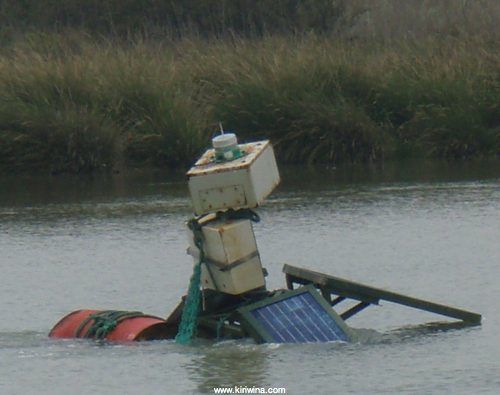
This rather tired looking British yacht was moored downstream of the main harbour.
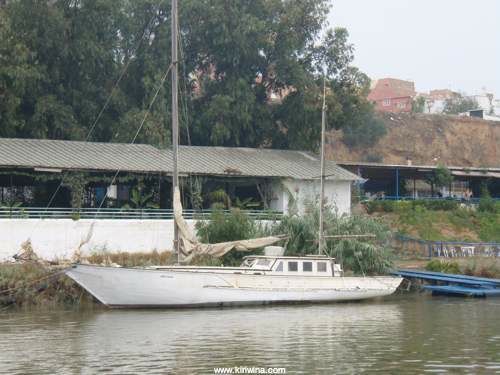
Entering Kenitra Harbour. Derelict quays and a wreck.
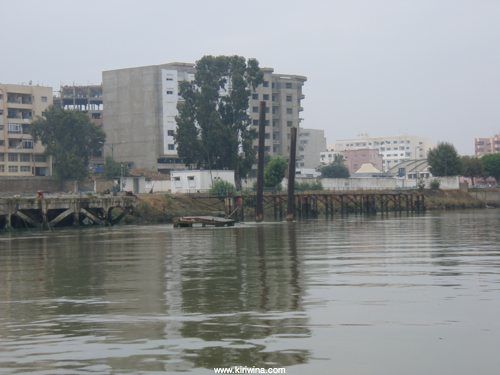
At 14:00 we arrived at Kenitra harbour. A trip of 2hrs and 10 minutes from the river mouth. The tide was in full flood and this part of the river was very very dirty. We had passed a sewer outfall about half a mile from Kenitra.
We got two lines ashore but did not moor. Instead we had a chat wth the harbour master who, while being very polite and friendly, strongly expressed the opinion that the port was not suitable or safe for small yachts. I agreed entirely. It might have been possible to find a space between the large tyre cluster fenders to moor but the quay had a substantial overhang which would have made it difficult and dangerous to be alongside as the tide fell. It would not have been possible to leave the boat unattended for any length of time.
The quay at Kenitra.
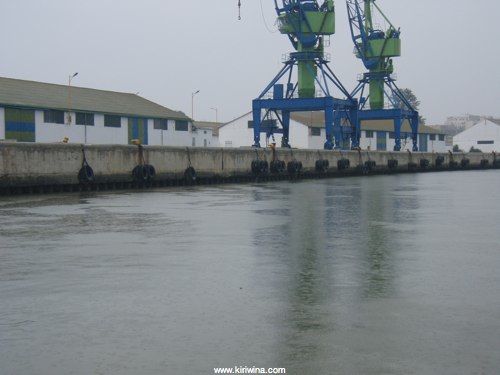
Possibly we could have sat alongside a small bulk carrier that was loading but I decided to cast off and proceed to Mohammedia.
"..is consequently very quiet, safe, and clean" I don't think so and wonder whether the writer actually visited Kenitra.
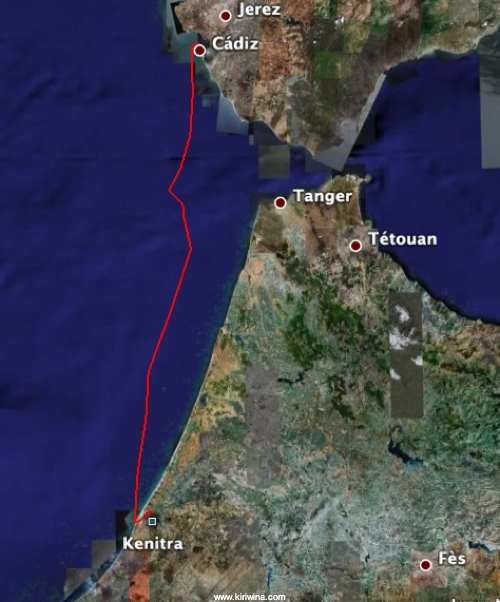
Up very early (06:00) for final preparations before leaving Cadiz at 08:00.
At first we had favourable but light winds and made slow progress with all sails up. As the day day progressed the wind veered from SE to W while maintaining F2-3. By Midnight we had covered only 28 miles.
During the night we saw a lot of Moroccan fishing boats and the VHF was alive with repeated calls from their skippers asking big ships to avoid crossing over nets.
There was also a steady stream of ships heading to or from the Strait of Gibraltar.
10th September 2007
Determined to avoid motoring we continued to sail at snails pace as the wind hovered around force 2 between S and NW. At 09:30 the foresails were furled and we deployed the ghosting genoa. By noon our mileage from Cadiz was 40.
At 14:00 with barely any wind we surrendered and put the engine on and motorsailed. At least we were making some progress.
At midnight our trip mileage was 80.
11th September 2007
During the early hours the sea was flat calm. As the morning progressed heavy rain set in and we could see the coast of Morocco.
A small bird hitching a lift in heavy rain with small Moroccan fishing boats in the background.

On Kenitra, the 2 year old pilot book commented "..is consequently very quiet, safe, and clean". So we chose Kenitra as our first port in Morocco.
At 11:45 we arrived off the entrance to the River Sebou where we dropped the main and proceeded in.
Old fort above the port of Mehdia at the entrance to the River Sebou

It was about 4 hours before highwater and we had to be careful to stay on the leads. Unfortunately these were difficult to identify and the GPS display showed us proceeding on dry land. Our Navionics chart was less than a year old and our Spanish paper charts were purchased less than two weeks ago. They were not a lot of help.
At 12:20 we kissed the muddy bottom at the edge of the shallows called Les Tables. We had been unable to spot the leads and wandered a tad too far to starboard.
After about 10 minutes the rising tide floated us off and we continued. The best policy was to stick pretty much to the middle but from then on we found most of the leads and followed a large fishing boat when we didn't.
Our GPS track.

A lower lead on the River Sebou. The bush to the left helpfully obscures the lead until one is almost abeam.

This buoy, marking a wreck, looks as though it is struggling to stay afloat itself.

This rather tired looking British yacht was moored downstream of the main harbour.

Entering Kenitra Harbour. Derelict quays and a wreck.

At 14:00 we arrived at Kenitra harbour. A trip of 2hrs and 10 minutes from the river mouth. The tide was in full flood and this part of the river was very very dirty. We had passed a sewer outfall about half a mile from Kenitra.
We got two lines ashore but did not moor. Instead we had a chat wth the harbour master who, while being very polite and friendly, strongly expressed the opinion that the port was not suitable or safe for small yachts. I agreed entirely. It might have been possible to find a space between the large tyre cluster fenders to moor but the quay had a substantial overhang which would have made it difficult and dangerous to be alongside as the tide fell. It would not have been possible to leave the boat unattended for any length of time.
The quay at Kenitra.

Possibly we could have sat alongside a small bulk carrier that was loading but I decided to cast off and proceed to Mohammedia.
"..is consequently very quiet, safe, and clean" I don't think so and wonder whether the writer actually visited Kenitra.

Cadiz
08/09/07 16:13 Filed in: Spain - Andalucia
We spent the day getting in last minute provisions and preparing for the crossing to Africa. I had a day of minor malfunctions. Leaving my glasses in El Corte Ingles (recovered later) and dropping part of our starboard sidelight into the water while attempting repairs.
The sidelight problem was interesting. Voltage readings were erratic and when we traced the wire another Northshore jagged edge problem revealed itself. A hole had been drilled into the pulpit rail to route the wire through to the boat interior. This hole had not been smoothed after drilling and over time the insulation had rubbed against the sharp edging and been worn away. Water had gradually seeped into the wire which was badly corroded at both ends. It will have to be replaced but we made a temporary repair and installed the Bebi LED bulb at the same time.
We didn't finish until fairly late and dashed off to the Gran Teatro Falla to buy tickets for Flamenco de Cadiz. Before the performance at 21:00 we had to do a round trip by taxi to El Corte Ingles to pick up my glasses.
As we had purchased late our tickets were for the top benches (not seats). It was a lovely theatre and the performance a lot of fun with a fair amount of audience participation including a wonderfully rythmic slow clap when proceedings were a little late getting under way.
The sidelight problem was interesting. Voltage readings were erratic and when we traced the wire another Northshore jagged edge problem revealed itself. A hole had been drilled into the pulpit rail to route the wire through to the boat interior. This hole had not been smoothed after drilling and over time the insulation had rubbed against the sharp edging and been worn away. Water had gradually seeped into the wire which was badly corroded at both ends. It will have to be replaced but we made a temporary repair and installed the Bebi LED bulb at the same time.
We didn't finish until fairly late and dashed off to the Gran Teatro Falla to buy tickets for Flamenco de Cadiz. Before the performance at 21:00 we had to do a round trip by taxi to El Corte Ingles to pick up my glasses.
As we had purchased late our tickets were for the top benches (not seats). It was a lovely theatre and the performance a lot of fun with a fair amount of audience participation including a wonderfully rythmic slow clap when proceedings were a little late getting under way.
Cadiz
07/09/07 18:34 Filed in: Spain - Andalucia
Departure day. It has been a very enjoyable month here and I have cleared my work backlog on the boat. That said, it would be difficult to recommend Puerto Sherry marina. It is over priced, and a long way from El Puerto de Santa Maria without any public transport links. A bit of a shame really as this area is spectacular with a lot to interest the visitor.
First up was a quick run into El Puerto to print out the insurance documents e-mailed to me. On the way back I purchased a replacement lifebuoy light. Then Tomas went round to Velas Climent to collect our new dinghy bag while I went and paid the marina fee.
Just as we were about to leave the skipper from "Ruby Tuesday" dropped by having just arrived. We had a quick chat and it is a shame he didn't arrive earlier as I would have liked to talk some more.
We went straight from our berth to the bunker berth. I had enquire whether they took credit cards and was told they did. And yes they did but their machine was malfunctioning so in effect they didn't. We took 105 litres of diesel at €1.10L and paid cash. Tomas phoned ahead to Puerto America Marina in Cadiz to enquire about berthing. No problem they said but as they had no 9m berths we woud have to pay for an 11m berth (€8 more). We declined to book.
It was 16:30 by the time we cleared Puerto Sherry and we then spent a couple of hours sailing around the Bay of Cadiz familiarising Tomas with the boat and gear. We had a good sail with 5.9 knots on the log at times.
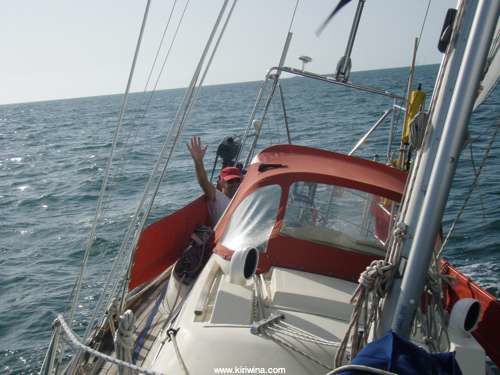
On arriving at Puerto America we just motored in and were directed to a waiting berth and I went up to the office to register. Surprise surprise, we were allocated a 9m berth at a cost of €16.64 per day.
Tomas cooked another excellent meal and we ate on board.
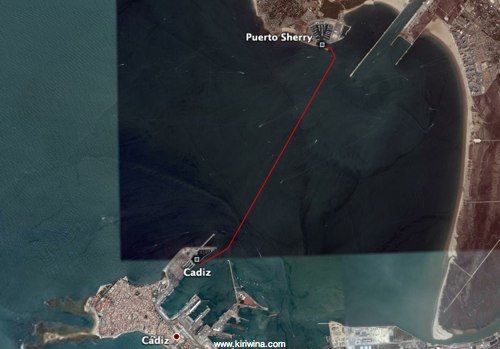
First up was a quick run into El Puerto to print out the insurance documents e-mailed to me. On the way back I purchased a replacement lifebuoy light. Then Tomas went round to Velas Climent to collect our new dinghy bag while I went and paid the marina fee.
Just as we were about to leave the skipper from "Ruby Tuesday" dropped by having just arrived. We had a quick chat and it is a shame he didn't arrive earlier as I would have liked to talk some more.
We went straight from our berth to the bunker berth. I had enquire whether they took credit cards and was told they did. And yes they did but their machine was malfunctioning so in effect they didn't. We took 105 litres of diesel at €1.10L and paid cash. Tomas phoned ahead to Puerto America Marina in Cadiz to enquire about berthing. No problem they said but as they had no 9m berths we woud have to pay for an 11m berth (€8 more). We declined to book.
It was 16:30 by the time we cleared Puerto Sherry and we then spent a couple of hours sailing around the Bay of Cadiz familiarising Tomas with the boat and gear. We had a good sail with 5.9 knots on the log at times.

On arriving at Puerto America we just motored in and were directed to a waiting berth and I went up to the office to register. Surprise surprise, we were allocated a 9m berth at a cost of €16.64 per day.
Tomas cooked another excellent meal and we ate on board.

Puerto Sherry
06/09/07 18:49 Filed in: Spain - Andalucia
The first job this morning was a visit to Velas Climent to arrange for some small adjustments to the work they had done.
Then a quick visit to the marina office. Finally my two packages had arrived. Delayed it seems by Correos slowdowns during the August holidays in Spain.
There has been no improvement in the weather. The forecast is still force 7 and gale force 8 winds. Yesterday, just down the coast near Barbate a fishing boat was overwhelmed by heavy seas and 5 people are missing.
Preparations for departure continued. The fresh water tanks were topped up with 200 litres and I bought some new padlocks and oil filters for the boat. The dinghy bag saga continued. Last September I was given a new dinghy bag in Gijon. Now, less than a year later, it is falling apart having been poorly constructed from inferior material just like the original bag supplied by Suzuki Marine.
During a safety gear check we discovered that an 18 month old Italian made lifebuoy light had failed due to extensive interior corrosion. Outrageous! It is supposed to be for marine use and the bit that failed, the mercury switch, had never been exposed to seawater. The failure was caused by condensation but coating the interior bits with vaseline would have prevented it.
Tomas made another visit to Velas Climent to arrange for a new bag to be made. It should be ready tomorrow. They had also finished the adjustments to the sprayhood and new sail cover.
With two people aboard again we will have to stow everything more efficiently. Tomas rearranged the galley and food storage and we set off to SuperSol with a big shopping list. I was on trolley driving duty while Tomas did the shopping. We left with a large load which, in addition to the food already on board, be sufficient to reach the Canaries even though we will be stopping in Morocco.
Back on board all this had to be stowed which it was although nets containing fruit, lemons, and onions are hanging at various points around the cabin.
Later Tomas prepared an excellent salad. He likes cooking. I like the fact that he likes cooking.
Then a quick visit to the marina office. Finally my two packages had arrived. Delayed it seems by Correos slowdowns during the August holidays in Spain.
There has been no improvement in the weather. The forecast is still force 7 and gale force 8 winds. Yesterday, just down the coast near Barbate a fishing boat was overwhelmed by heavy seas and 5 people are missing.
Preparations for departure continued. The fresh water tanks were topped up with 200 litres and I bought some new padlocks and oil filters for the boat. The dinghy bag saga continued. Last September I was given a new dinghy bag in Gijon. Now, less than a year later, it is falling apart having been poorly constructed from inferior material just like the original bag supplied by Suzuki Marine.
During a safety gear check we discovered that an 18 month old Italian made lifebuoy light had failed due to extensive interior corrosion. Outrageous! It is supposed to be for marine use and the bit that failed, the mercury switch, had never been exposed to seawater. The failure was caused by condensation but coating the interior bits with vaseline would have prevented it.
Tomas made another visit to Velas Climent to arrange for a new bag to be made. It should be ready tomorrow. They had also finished the adjustments to the sprayhood and new sail cover.
With two people aboard again we will have to stow everything more efficiently. Tomas rearranged the galley and food storage and we set off to SuperSol with a big shopping list. I was on trolley driving duty while Tomas did the shopping. We left with a large load which, in addition to the food already on board, be sufficient to reach the Canaries even though we will be stopping in Morocco.
Back on board all this had to be stowed which it was although nets containing fruit, lemons, and onions are hanging at various points around the cabin.
Later Tomas prepared an excellent salad. He likes cooking. I like the fact that he likes cooking.
Puerto Sherry
05/09/07 18:48 Filed in: Spain - Andalucia
The weather forecast was ominous. Force 7 and gale force 8 east to south east winds. I had considered doing a shakedown sail in the Bay of Cadiz but we won't be going anywhere today.
Still no sign of my two packages although I received e-mails confirming both had been sent over a week ago.
Much of the day was spent familiarising Tomas with the boat and we collected the repaired sprayhood and new sail cover and sun awning from Velas Climent. On time and on budget. I'm a happy customer and I also bought 6m of awning fabric from them.
Later we went into El Puerto de Santa Maria to say goodby to friends who were leaving. Then we went to an internet cafe to do some printing. I needed to print 16 pages. The cafe was windows only so I had to e-mail the documents to myself, access them online using a Windows computer, and then print each document.
What a nightmare. What would have taken a couple of minutes on the Mac took an hour and a half on Windows. Each document had to be put through a horrible piece of software called, I think, Microsoft Photo Editor. Yuk!
On the way back our taxi driver recommended a good bicycle shop where I was able to buy new brake pads for the Brompton. Fitting these eliminated the screech when braking.
In the evening we tried out an Italian restaurant, Blanca Paloma, quite close to the marina. We won't be going back
Still no sign of my two packages although I received e-mails confirming both had been sent over a week ago.
Much of the day was spent familiarising Tomas with the boat and we collected the repaired sprayhood and new sail cover and sun awning from Velas Climent. On time and on budget. I'm a happy customer and I also bought 6m of awning fabric from them.
Later we went into El Puerto de Santa Maria to say goodby to friends who were leaving. Then we went to an internet cafe to do some printing. I needed to print 16 pages. The cafe was windows only so I had to e-mail the documents to myself, access them online using a Windows computer, and then print each document.
What a nightmare. What would have taken a couple of minutes on the Mac took an hour and a half on Windows. Each document had to be put through a horrible piece of software called, I think, Microsoft Photo Editor. Yuk!
On the way back our taxi driver recommended a good bicycle shop where I was able to buy new brake pads for the Brompton. Fitting these eliminated the screech when braking.
In the evening we tried out an Italian restaurant, Blanca Paloma, quite close to the marina. We won't be going back
Puerto Sherry
04/09/07 18:47 Filed in: Spain - Andalucia
No sign of my mail so I e-mailed suppliers seeking shipping confirmation.
On board I freed up some storage space for Tomas who is due to arrive today. I enquired at the marina office about obtaining outward clearance as we will be going outside the EU to Morocco. Carlos, who was snippy with me the other day, suggested I go to the police station. I don't think so.
A problem has developed with the brakes on the Brompton. A load screech is emitted when the brakes are applied. It must be the brake pads but there looks to be plenty of unused compound.
Later Tomas telephoned to say he would b arriving at around 21:30
He duly arrived on time and after freshening up we went into town for drinks and tapas with friends.
Returning to the friends house we found a young couple dancing on the roof terrace.
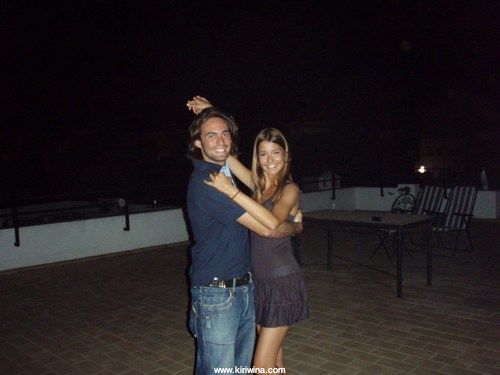
Tomas likes dancing, first with our host...
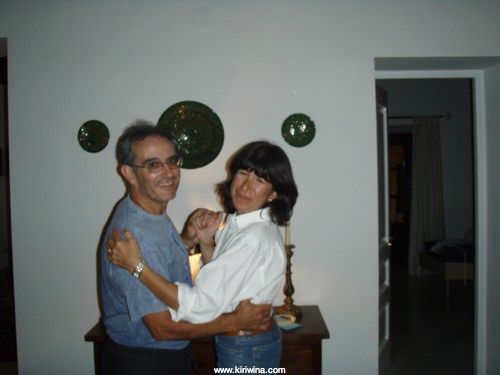
....and then with the girl from the roof terrace.
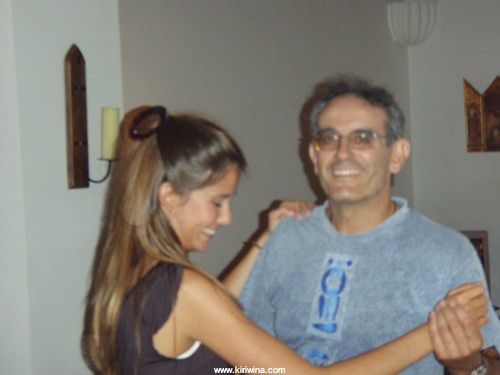
On board I freed up some storage space for Tomas who is due to arrive today. I enquired at the marina office about obtaining outward clearance as we will be going outside the EU to Morocco. Carlos, who was snippy with me the other day, suggested I go to the police station. I don't think so.
A problem has developed with the brakes on the Brompton. A load screech is emitted when the brakes are applied. It must be the brake pads but there looks to be plenty of unused compound.
Later Tomas telephoned to say he would b arriving at around 21:30
He duly arrived on time and after freshening up we went into town for drinks and tapas with friends.
Returning to the friends house we found a young couple dancing on the roof terrace.

Tomas likes dancing, first with our host...

....and then with the girl from the roof terrace.

